FUTURE RETAIL
Greying demos, eco-shoppers and universal brandscapes


Greying demos, eco-shoppers and universal brandscapes


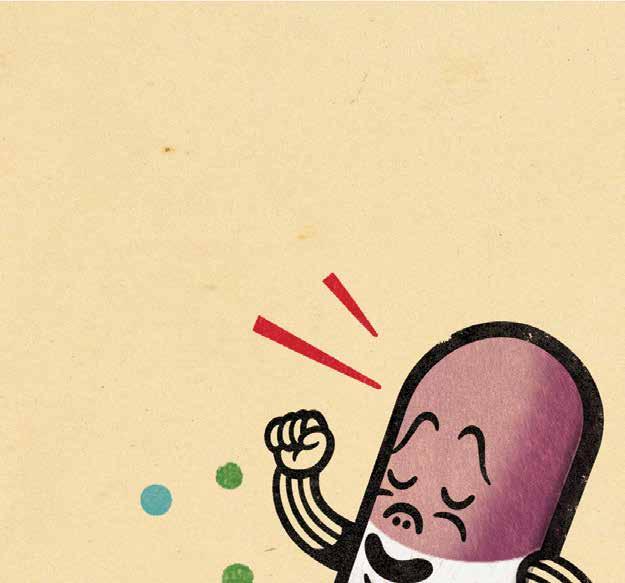
Sponsored Supplement
Strategy's 5th annual Pharma Report shines a spotlight on how agencies are innovating and helping brands rede�ine the healthcare marketing space. Share how your company plays an integral role.
Commitment deadline: July 25
To book your spot contact Neil Ewen at newen@brunico.com

SUMMER 2023
16 23 12
See what global trailblazers are doing when it comes to more sustainable packaging solutions.
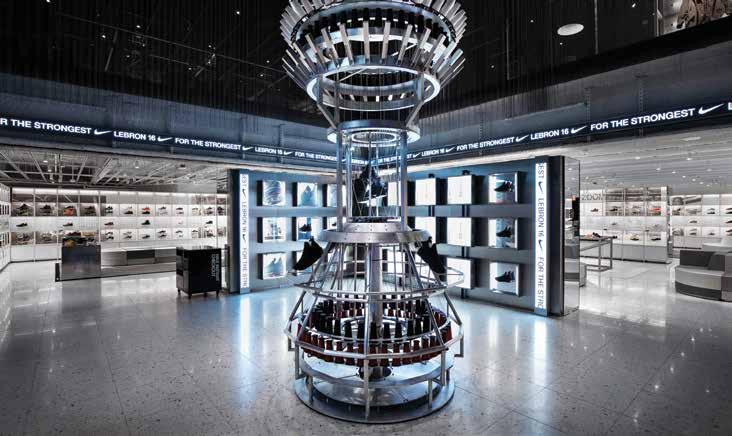
Our experts weigh in on the factors they think will have the greatest influence on retail in the next five to ten years.
Marketers and media agency execs gather to discuss how some of their new, cookie-less approaches have fared.
4 Editorial Can we really predict the future?
• 6 Upfront Filling in our blind spots, making really good ice cream and dealing with the impact of a greying population
• 30 Pepsi celebrates 125 years with a brand refresh (and Cheetos has a birthday, too)
• 62 Hall of Marketing Gold Welcome three new inductees!
• 64 Forum Seriously. Stop wasting time.

ON THE COVER: What will the retail space of the future look like? Well, that's a tough call. It's always hard to predict the future. Weren't we promised jet packs and flying cars at some point...?
But, at least when it comes to retail, you can look to the trends and factors that will likely have the biggest influence. Think of things like demo shifts, scarcity, inclusivity, universal brandscapes and AI. But, yeah, I still want my jet pack, dammit. Don't think I forgot about that. (Cover illustration by Tom Froese.)
THE A-LIST

SPONSORED SUPPLEMENT 33 Status quo doesn’t cut it anymore. Just look at how Canada’s top brands approach marketing to see how much has changed. But how to achieve that next level? This year’s A-List is cross- section of agencies have proven their creativity and innovation strength on the awards circuit show how advertising can have a meaningful impact on the world, while building brand equity and business.
Afew of our features this issue – including our look at what the next decade of retail might look like – have me considering how impossible it is to predict the future with any sort of certainty.
Of course, we have data and trends, and conventional norms that suggest a path we’re likely to follow. But, as accurate as they may turn out to be, those are really just suggestions of what’s to come. There’s no way to be certain that what’s past is prologue (with apologies to William Shakespeare). The future is a tempest of possibilities, some more likely than others, but all within the realm of the possible.
Consider the potential impact of an aging Boomer demographic, 15-minute cities, looming scarcity, urbanization and Generation Alpha alone. It all makes predicting the future a tough gig – especially for marketers (with their DNAlevel obsession about knowing what’s coming next).
In the end, that’s why I’m not overly worried about AI. From a creative standpoint, artificial intelligence is – as it stands now, anyway – derivative. It’s the summation of our experience to date, not a secret window into what’s to come. It’s an imposter that poses, deep in thought, before it cribs someone else’s homework or makes a guess at the answer that’s as wild as any of ours. (As an aside, I’ve found it lies as much as we do, too.) Maybe it develops the ability to predict and create, but that’s not where we are now.
Mark Twain is often reputed to have said: “History doesn’t repeat itself but it often rhymes.” And, he’s probably right. What’s come before is often a good enough predictor for most of us in the day to day. But ask any sports fan and they'll tell you that even the best odds often don’t pan out. In fact, the universe seems to take pleasure in serving up the unexpected.
For me, it really comes down to the fact that what’s been is less interesting than what’s to come, or what’s possible. We still need human creativity and that guiding voice of experience to figure our way forward – and the instinct to know when things are about to go sideways (as they so often do), even in the face of reasonable odds.
But, more importantly, we’re going to need all our collective wisdom to build the future we want to see. And, really, that’s the future I’m most interested in.
Speaking of the future… This issue marks my last as interim editor. It’s been an honour to fill in for strategy editor and content director Jennifer Horn on the magazine side this past year. She returns to guide the ship for the fall issue – with our annual Agency of the Year report.
Brendan Christie Interim Editor, strategy
summer 2023 volume 34, issue 3 strategyonline.ca
publisher | lisa faktor | lfaktor@brunico.com
content director, editor | jennifer horn | jhorn@brunico.com (leave)
interim editor | brendan christie
art director | tim davin | tdavin@brunico.com
special reports and c-suite editor | sheima benembarek | sbenembarek@brunico.com
associate editor | chelsea clarke | cclarke@brunico.com
associate publisher | neil ewen | newen@brunico.com
digital editor | josh kolm | jkolm@brunico.com
senior reporter | justin crann | jcrann@brunico.com
senior reporter | chris lombardo | clombardo@brunico.com
intern | noor abduljabbar | cnabduljabbar@brunico.com
contributers | mike connell, wendy kan
account manager | conidon pinto | cpinto@brunico.com
account manager | nupur purohit | npurohit@brunico.com (leave)
marketing co-ordinator | emily yuill | eyuill@brunico.com
CORPORATE
president & ceo | russell goldstein | rgoldstein@brunico.com
evp, strategy and realscreen & editorial director brunico | mary maddever | mmaddever@brunico.com
director, finance & administration | michelle plaskon | mplaskon@brunico.com
creative services & dist. manager | adriana ortiz | aortiz@brunico.com
customer support supervisor | christine mcnalley | cmcnalley@brunico.com
how to reach us
Strategy, 366 Adelaide Street West, Suite 100, Toronto, Ontario, Canada M5V 1R9
Tel: (416) 408-2300 or 1-888-BRUNICO (1-888-278-6426) Fax: (416) 408-0870 www.strategyonline.ca
customer care
To order a subscription, visit strategyonline.ca/subscribe. To make a change to an existing subscription, please contact us by email: strategycustomercare@brunico.com.
Tel: (416) 408-2448 Fax: (416) 408-0249. 8799 Highway 89, Alliston, ON L9R 1V1.
subscription rates
STRATEGY is published five times per year by Brunico Communications Ltd.
In Canada: One year CA$80.00 Two years CA $144.00 (HST included. Registration #856051396 RT)
Single copy price in Canada is CA$6.95. Please allow four weeks for new subscriptions and address changes.
copyright and trademark
STRATEGY and the tagline “Bold vision brand new ideas” are trademarks of Brunico Communications Ltd. All rights reserved. Nothing may be reproduced from STRATEGY in whole or in part without written permission. Reprint requests should be sent to rgoldstein@brunico.com. © 2018 Brunico Communications Ltd.
postmaster notification
Canadian Postmaster, send undeliverables and address changes to: Strategy, 8799 Highway 89, Alliston, ON L9R 1V1 strategycustomercare@brunico.com
U.S. Postmaster, send undeliverables and address changes to: Strategy PO BOX 1103 Niagara Falls NY 14304 Printed in Canada. Canada Post Agreement No. 40050265. ISSN: 1187-4309.
Member of
FROM A CREATIVE STANDPOINT, ARTIFICIAL INTELLIGENCE IS – AS IT STANDS NOW, ANYWAY – DERIVATIVE. IT’S THE SUMMATION OF OUR EXPERIENCE TO DATE, NOT A SECRET WINDOW INTO WHAT’S TO COME.
The Cannes Lions International Festival of Creativity is the largest gathering in the creative community and where the Cannes Lions Awards are announced. I would like to offer my sincere congratulations to the Canadians who have been named to the 2023 Cannes Lions juries. As the most recognized and prestigious marketing and advertising awards in the world, the selection of these jurors once again recognizes the world class expertise in the Canadian marketplace. On behalf of the Canadian advertising industry, congratulations to the leaders named to this year’s Cannes Lions Awarding and Shortlist Juries.
Andrew Saunders
Chief Revenue Officer, The Globe and Mail Chair, Canadian Cannes Lions Advisory Board













Cannes Lions Awarding Jurors
Design
KATE BATE COO, Tendril Design + Animation and Forever Co









Canada
Health & Wellness
NEILL BROWN President, IPG Health
Creative Effectiveness
Film
TYLER TURNBULL Global CEO, FCB

Brand Experience & Activation
DOUG MUIR Executive Creative Director, PROOF Experiences
LEIA ROGERS Partner, Executive Creative Director, Rethink
SCOTT PINKNEY SVP, Executive Creative Director, Publicis Hawkeye
JORDAN DOUCETTE Chief Creative Officer, Canada, Dentsu

Director, Brand and Design, Sid Lee Industry Craft NANCY CRIMI-LAMANNA Chief Creative Officer, FCB Canada Creative Commerce - President ANDREW SIMON Global Creative Director, Edelman Public Relations BRENT CHOI CEO, Angry Butterfly Social & Influencer JAY CHANEY Partner & Chief Strategy Officer, Broken Heart Love Affair Creative Strategy CHRISTINA YU Director/Creative, Merchant Films Film Craft MAN WAI WONG VP, Group Creative Director, Leo Burnett Outdoor SUSAN IRVING Chief Marketing Officer, Kruger Products Inc. Entertainment for Sport SONIA CARRENO President, Interactive Advertising Bureau of
Direct HELEN GALANIS CEO, Initiative Canada
 The Globe and Mail is proud to be the official Festival representative in Canada for the Cannes Lions International Festival of Creativity.
CANADIAN PROGRAM PARTNERS
The Globe and Mail is proud to be the official Festival representative in Canada for the Cannes Lions International Festival of Creativity.
CANADIAN PROGRAM PARTNERS
The Marketing Awards just wrapped on 101 years spent recognizing Canadian creativity, and we’re proud to see that the work coming out of Canada continues to be nothing short of amazing.
I often geek out on the impact that advertising has had at the intersection of culture and society – creative influence acting as a force for change; helping to build a better future while building better brands.
The adage “to know where you’re going, you need to know where you come from” certainly shines in this issue, as we look at the impact of the industry builders, innovators and leaders inducted into strategy’s second annual Hall of Marketing Gold this year.
We celebrate Judy John (pg. 62), whose fearless work sparks cultural conversation while tackling hard issues in a way that's relevant for marketers. She creates meaningful work that just makes sense.
And Frank Palmer (pg. 63), the adland prankster, who is known for cultivating creative bravery across both agency and client alike. Having the vision to always aim higher and empower his teams to do the same has launched generations of changemakers in our industry.
We also look at the mark left by the late Don Watt (pg. 63). He forever shifted retail norms with his keen design-thinking approach. His stripped-back, yet impactful, style broke through the blandness of retail, catapulting iconic brands into
our collective consciousness.
The impact of such visionary leadership and a desire to resist the expected path is evident in the creative ethos that continues to propel Canadian talent – both here, at home, and on the global front.
The urge to constantly evolve and innovate is helping craft better agency partners. This is evident in our annual Agency A-List supplement (pg. 37), a spotlight on Canada’s winningest agencies, which are challenging industry norms to better meet clients’ evolving business needs. From helping brands stay relevant by stepping outside the “advertising bubble”, to connecting with audiences through purposeful investment, these agencies are carving out a new space.
This issue, we also dive into what’s driving change across the retail landscape, from our cover story on the forces shaping shifts in shopping (Future of Retail, pg. 16) to next-level sustainable packaging solutions (pg. 12).
As we recognize the power of our marketing media investment, in tandem with our messaging’s power to persuade, the recentlylaunched 2023 Media Innovation Awards introduces a new category this year: Planning with Purpose. The goal is to celebrate the media programs that embody inclusivity and sustainability.
On the leadership front, we’re looking for nominations to help identify this year’s Media Leader
THE IMPACT OF SUCH VISIONARY LEADERSHIP AND A DESIRE TO RESIST THE EXPECTED PATH IS EVIDENT IN THE CREATIVE ETHOS THAT CONTINUES TO PROPEL CANADIAN TALENT – BOTH HERE AT HOME AND ON THE GLOBAL FRONT.
of the Year. We want to know who set the bar high and spearheaded change for a better, stronger media ecosystem – and then some.
On the CMO side of that equation, we’re also looking for Brand of the Year and Marketer of the Year nominations. So, let us know who rose above the competition this year.
And please join us on October 2 for our annual CMO summit for frank discussions on the pressing issues facing Canadian brands, and a deepdive into the opportunities ahead.
Also mark your calendars to connect and celebrate with the industry at our annual Agency of the Year gala, which returns November 2, as well as the MIAs gala on November 29.
As we continue to plan ahead, we want your feedback, so let us know if you want to see new coverage areas, or more or less of anything.
And, as Canadians descend into the South of France (at press time), we’re eager to continue to shine a bright light on just how far Canadian creativity has come on the global stage at Cannes Lions.
Until then, cheers.
Lisa Faktor, publisher, strategyP.S. Send your Media Leader of the Year, Brand of the Year and Marketer of the Year nominations to special reports and c-suite editor, Sheima Benembarek, at sbenembarek@brunico.com any time in July.


We know inclusivity and representation are good for society – and good for business. So why isn’t foundational and representational change happening faster?
That’s a question being posed by Sarah Thompson, president of Dentsu Media Canada. “Top-down, there is a general need for CMOs to start addressing what they believe is a responsible advertising playbook,” she says – a need to align values around sustainability and inclusivity with marketing and advertising policies that go beyond so-called care washing.
“This is the month for care-washing where you throw on a rainbow logo and all of a sudden you’re supporting the LGBTQ community,” she adds. “You’re going to get called out for that.”

So, why the slow progress? Well, like all good marketing solutions, it comes down to access and authenticity. Brands needs to be in the spaces in
which communities gather, and support the channels and platforms that meaningfully speak to them. But what if we have blind spots we’re not even aware of? Says Thompson, “A majority of planners don’t know what data is missing when planning out investment strategies and approaches.”
Case in point: Indigenous audiences. It’s a cohort that now accounts for about 5% of the Canadian population. According to StatsCan, the Indigenous population grew by 9.4% from 2016 to 2021, surpassing the growth of non-Indigenous Canadians (+5.3%). There are now more than one million First Nations people living in Canada, and the population living in large urban centres (801,045 people) has grown by 12.5% in that time.

The Aboriginal Peoples Television Network (APTN) is mandatory carriage in Canada – a decision made by the CRTC in 1999 to “recognize the immense value of offering Indigenous

perspectives, cultures and languages to Canadian audiences,” says Monika Ille, CEO of APTN.

Yet, despite being on every cable and satellite provider nationwide, Ille says Numeris, the exclusive provider of viewership data for television and radio broadcasters in Canada, “does not offer any means to identify Indigenous viewers, which poses a significant challenge for us in accurately understanding and catering to our target audience.”
And this isn’t a singular challenge, Thompson asserts. “There are 1.5 million new Canadians, and a lot of them are Indian,” she says by way of example. “They don’t have a local media ecosystem, so they’re going to be relying on media from where they are immigrating from, and that makes it very hard for brands to reach those audiences.”
The stats underline the problem. Canada’s population was estimated to be just shy of 40 million at the start of the year, after record population growth of over one million people in 2022 – more than 400,000 of whom were immigrants. It’s the first time in Canadian history that the population grew by that much in a 12-month period. (Canada led the G7 for population growth in 2022, as we have for many years.) Consider, too, that Canada is also now home to approximately one million people in the LGBTQ2+ communities.
So, how do you know any campaign targeting these cohorts is working if audiences aren’t being adequately measured or represented?
“One of the things we have to temper is that notion of evidence,” says Thompson. Fast-moving metrics that you get from other platforms don’t necessarily translate into business outcomes. She adds: “brands want market share or growth,” so if you’re stalling on growth, “it may not be your media or your creative messaging.” Instead, she suggests it might be time to look at who you think you’re talking to and who is included in your media planning – and who’s excluded.
“You’re excluding someone as soon as you start targeting, or using the word ‘target,’ or saying ‘18 to 54,’ or saying ‘moms,’” she suggests. “To what end? Let your media agency determine that. We’ll figure out a way to invest and make sure it does what’s expected while being more inclusive of who is in Canada and who actually represents a business opportunity.”
This is where Thompson says planners and agencies need to start challenging the norm. For example: “Connect with the Indigenous communities, do things that are meaningful, make sure their media is supported and we’re including them in the conversation.
“If we do all of these things, the business outcome will come.”
What’s it take to get consumers to pay attention to environmentalism these days? Consider an event by Tushy, a Canadian BIPOC and female-founded company that transformed from a tech start-up into a globally-recognized bathroom brand. It stands behind those who fight for the environment, even if it’s just by washing their behind instead of using toilet paper. (The toilet paper industry has contributed to the deforestation of 28 million acres of Canadian forests since 1996, after all.) For World Environment Day this summer, the brand, founded by Miki Agrawal (pictured), collaborated with photographer Ara Coutts for a free, one-of-a-kind, adults-only gallery exhibit called “Asshole Activists.” What’s so special about it? Lots of (very) close-up photographs of real rears as a unique way to bring awareness to this important environmental issue. “Tushy saves your butt, your wallet and the planet,” shares Justin Reekie, VP of marketing at Tushy.
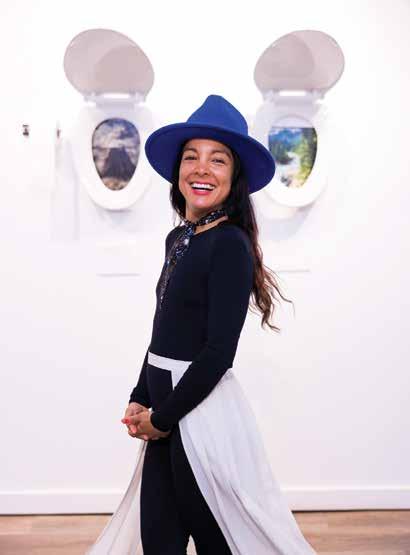
FOR THE FIRST TIME IN, WELL, EVER, Canadian ice cream giant Chapman’s is collaborating with another business for a premium coffee blend ice cream flavour release. Their pick of partner? An increasingly popular, cause-driven and Ojibway-led coffee company called Birch Bark Coffee.
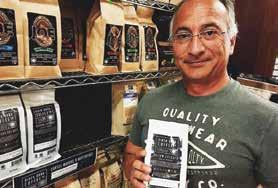
When the founder (and band member of the Whitefish River First Nation) Mark Marsolais-Nahwegahbow was setting up the Ottawa-based business in 2018, he knew he couldn’t afford a brick-and-mortar shop. “I was introduced to e-commerce, through Shopify, and I brought on a team to help me out. Within about 30 days, we received a call from them to tell us that they were highlighting my business.” Shopify spotlighted several Indigenous companies of note for National Indigenous History Month, with a special focus on Marsolais-Nahwegahbow’s offering.
Soon after, small mom-and-pop stores began asking to carry his product. Then big retailers, like Metro Glebe, came knocking and food services like Chartwells Compass Canada, Sodexo and Aramark followed suit. As the company’s marketing picked up, the Chapman family got in touch with an offer for a special partnership. They wanted to use Birch Bark coffee concentrate, a special cold brew, to make coffee ice cream and release it this spring.
“I had no idea that I was going to take off and go viral like I did. Really, all I wanted to do was bring education and awareness to the many problems that nobody’s really doing anything about. Coffee can make a difference.” SB
Coffee can make a difference.
Starting her Wendy’s career in 2008 as VP of new product offerings, Liz Geraghty has led the QSR’s marketing since 2020, where her efforts reach over 30 countries. Her tenure has seen the launch of iconic menu items such as the Apple Pecan Chicken Salad, Spicy Nuggets and Cut Sea Salt Fries, and she’s also the mastermind behind the transit-riding, breakfast-eating viral sensation, French Toast Guy. Geraghty is a class act at heart, evident in her go-to Wendy’s order: a Dave’s Single.
I love to read and listen to audio books or podcasts. I’m currently listening to the autobiography Surrender by Bono, the lead singer of U2. It’s a personal and fascinating story that in some ways is a love story about his relationships with his family and band mates. It’s those relationships and the love that surrounds them that inspires the band’s continued creativity for over 35 years. I believe that having people and experiences in your life that bring you joy is a way to fuel your creative spirit.

I also like the theme of the book, Atomic Habits, and enjoyed listening to the author James Clear. It’s a simple, yet powerful idea that big changes come from the small things you do every day. He also debunks the myth that people fail at changing their habits because of a lack motivation. He believes most people fail because of a lack of clarity. For example, if you want to eat healthy or exercise more, you need to schedule that time into your day. Once you do, the positive feelings that emerge from these small changes become a virtuous circle.
Is there something that has inspired you most over your career?
I’ve been most inspired by people who bring and give energy. When I’m around leaders who give energy, my energy increases to match theirs. I always try to surround myself with smart people because, just like playing sports, when you play with a person or team who is better, your game naturally improves.
What media are you following now?
Outside of everything related to food and restaurants, I love podcasts or audio books, especially those focused on non-fiction or historical fiction. My favourite podcast of the past five years was a piece about the rock band Scorpions and the role they might have played in the fall of the Soviet Union with their song, “Wind of Change.” I find that kind of stuff fascinating.
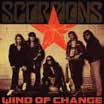
If you weren’t doing what you’re doing...?
I would probably be a struggling actor. I wouldn’t be very good at it (hence struggling), but I love the theatre. I love telling stories, and I’ve always dreamed of being a performer.
Like many western nations, Canada is getting older – and it’s a trend that’s going to continue. According to StatsCan, the proportion of seniors (65-plus) in the population will increase from 18.5% in 2021 to as high as 29.8% in 2068 (depending on how Canada’s population grows). The number of older seniors (85-plus) will also climb rapidly, particularly between 2031 and 2050 as the baby-boomers enter the age group. While this demo numbered 871,400 in 2021 – double
what it was in 2001 – expect it to grow to between 2.8 million and 3.6 million by 2068. In fact, it’s one of the country’s fastest-growing groups.
With Boomers already representing upwards of 60% of consumer spending power, appealing to older generations is going to become increasingly important in future.
Luckily, we don’t have to reinvent the playbook. Lisa Reid, country leader for P&G Beauty Canada, insists that the goal – for this or any other demo
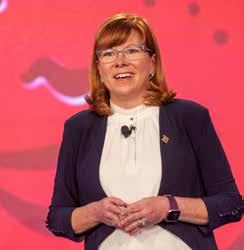

should always be about solving problems and being representative in your messaging.
P&G brand Olay is a good example, she says. While it’s an iconic brand that has been around for a long time, she says they “thought very intentionally around the idea that, although the highest dollars in the skincare category are found in the 18 to 35 users and spenders, women of all ages have skincare needs, which can be met with the great range of products that we have.”
So, the 59-plus consumer is actively represented in all of their marketing efforts. Whether it’s packaging (Herbal Essences effected a more inclusive design strategy, with colour as well as tactile indicators to ensure users could easily differentiate between shampoo and conditioner), or product design (P&G’s
the shower and if the cap is easy to open.
“I walk through stores every week,” Reid explains. “I watch people shop. You have young parents with kids, or Boomers with mobility issues who may only have one hand to shop with,” so what insights can you get and learn from there?
It’s a good approach. After all, this is a cohort that likes shopping. According to 2023 data from the Hubspot State of Consumer Trends Report, Boomers prefer retail shopping more than any other generation, with 44% saying they have discovered new products in retail stores in the past three months, and 38% saying that’s where they find new items most often. (Though TV remains the prime driver: 53% of Boomers have discovered new products through TV ads in the past
expertise, services and affordable products to meet any ability by creating a one-stop destination for universal design options.
Johanna Faigelman, founding partner and CEO of HumanBranding, a research consultancy focused on the application of anthropology in marketing and business, describes Boomers as unlike what has come before – and that offers opportunity. “Seventy is the new 50,” she says. This is a demo that shows an “unwillingness to conform to previous generation’s definition of what a career looks like. Midlife and retirement have been drastically transformed by Boomers. Menopause used to be the end of something, now it’s the beginning of something else.
“They want to feel young and healthy, so if you can tap into that and you have a good, ethical story behind your brand, I think you can captivate that audience.”
It’s one of the reasons brands like Seattle-based Leisure Care, one of the largest privately held retirement and assisted living companies in the U.S., decided to evolve. The company recently announced it was updating it’s branding to meet the needs of the next generation of retirees. The new positioning is all about joy, purpose and passion. Or, as it describes their target market on its home page and social: “Rather than sitting in a rocking chair, they want to keep rocking – and we’re helping them do just that.”
Hair Biology brand was specifically designed for “that peri-menopausal and beyond stage”), Reid says that it’s all about going back to the fundamentals.


“Design from the experience back,” she says. What’s the problem the product can solve and how will the consumer use it? Branding-wise, it’s not just about differentiation on the shelf, it’s also about asking if the user is wearing their glasses in
three months, and 62% say their TV set is where they discover products most often.) What drives Boomer purchasing? Primarily price (80%) and quality (77%).
It’s that kind of intel that recently drove home reno brand Lowe’s to announce ‘Lowe’s Livable Home’ for the U.S., a multi-year commitment to become the leading retail destination for aging-inplace solutions. The initiative plans to offer
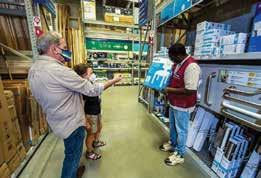
Reid advises brands to just keep learning – even scouring Google, Yelp and Amazon reviews, whether to identify and fix a problem consumers are experiencing with a product, or highlighting and educating around a benefit many aren’t aware of. There are no one-size-fits-all conversations or solutions with this demo, she says: “Making broad assumptions about any age group is a mistake, so the key is to design around the solution or need change.”
The pay-off will be worth it. “These people are ready to spend,” sums Faigelman. “They are ok with reinvention, and they’re willing to invest in themselves, their families and their pets. They’re not sticks in the mud or traditional old people. You better not think of them that way, or you’re going to miss the boat.”

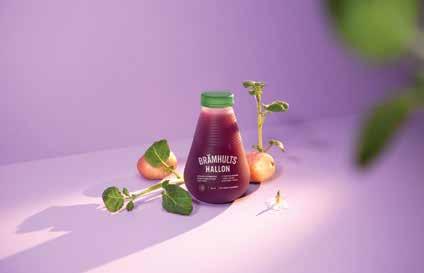
We’ve got two requirements for innovative packaging solutions: They shouldn’t harm the environment or inconvenience our daily routines. And with research showing that food packaging waste comprises approximately one-third of all household waste, clearly, there’s some room to grow. To inspire change and forge a different path, we’ve rounded up a few of the newest global trailblazers in sustainable packaging solutions.
BY CHELSEA CLARKEJust when you thought drinking alcohol out of paper was unbecoming, Amherstburg, Ontario’s Wolfhead Distillery challenges conventions. It’s the first craft distillery to launch spirits in a paper bottle, one developed in partnership with Kinsbrae Packaging in Cambridge, ON. The bottle is lightweight, 100% recyclable, and has an 84% lower carbon footprint compared to a glass bottle. Spurred on by an LCBO challenge to introduce eco-friendly packaging, Wolfhead’s paper bottle took two years to develop, plan and design, and made it to shelves in time for St. Patrick’s Day.

Positively overwhelmed by the amount of reusable water bottles piled up in your recycling bin? Say no more because
Swedish design studio Tomorrow Machine has a solution: GoneShells is a bottle made from a potato-starch-based material that’s designed to hold liquid, then meant to be discarded. Peeling the container like an orange causes it to become compostable or dissolvable. GoneShells tells us you can also eat the container, but we’ll let you be the guinea pig on testing that particular method. Keep us posted.
Seaweed: Not just for sushi rolls or getting caught in while swimming anymore. UK-based Notpla has created a line of eco-friendly packaging materials made from globally abundant and fast-growing seaweed, including takeaway food and bev containers, flexible film bags, rigid plasticlike solutions and more. Notpla’s materials are classified as natural and organic by EU law, making them truly biodegradable and home-compostable.

The daily coffee run made eco-friendly and innovative. Hong Kong-based ChoosePlanetA’s Good Cup has an integrated lid that folds in on itself and locks in place. The cup is made entirely from sustainable paper created from renewable sources such as sugarcane waste, and manufacturing is compatible with existing machinery that already produces traditional cups. Another bonus: Good Cups pack flat, saving storage space and energy used in transportation.
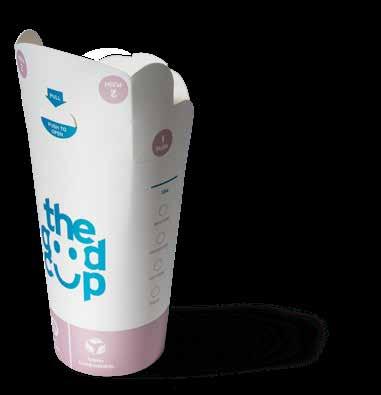
We’ve all been there: You snag the latest shade of lipstick from your favourite brand, only to discover you’re really more of a winter. What a waste – of packaging, that is. But UK cosmetics brand Morrama is aiming to change that with a line of refillable lipsticks, palettes and creams. While refillables aren’t exactly a new concept in the beauty space, Morrama has factored in additional barrier solutions such as compostable instead of recyclable packages, recycling-friendly package liners, and storage-solutions for rarely used shades you’re simply not ready to part with yet.

Above/Centre: Seaweed is fast-growing and globally abundant – ideal for Notpla’s ecofriendly alternatives to plastic. Left: The Good Cup boasts its own built-in lid. Below: Swap out Morrama’s cosmetics, not its containers.











































Submissions for the Young Lions Competition are judged by an esteemed panel of industry experts. Juries of experienced advertising and marketing executives review, debate and determine the top winning teams.

Thank you to our jury chairs and jurors:


Allen Kwong, Group Creative Director, TAXI
Dean Lee, Executive Creative Director, Zulu Alpha Kilo
Israel Diaz, Founder, Sunday+Night Inc.
Keli Pollack, Creative Director, Daughter Creative
Marie-Ève Best, Executive Creative Director, LG2
Marta Hooper, Chief Creative Officer, Rain
Mo Bofill, Partner, Creative Director, Design, 123w
Natalie Bomberry, Vice President, Operations, Pilot PMR
Pam Danowski, Creative Director, GUT
Stephen Flynn, Creative Director, Wunder
Alexandre Gadoua, VP, Creative Lead, Cossette
Darian Kovacs, Founder, Jelly Digital Marketing & PR
Fernando Muto Brevilieri, Creative Director, Critical Mass
Francesco Grandi, Chief Creative Officer, Ogilvy
Jess Willis, Group Creative Director, Performance Art
Karen Howe, Founder, The Township Group
Rica Eckersley, Executive Creative Director, DDB Canada
Zachary Bautista, Partner and Creative Director, Rethink
Alastair Taylor, Chief Executive Officer, Publicis Media
Alicia Petralia, Head of Media, Zulumatic
Brooke Leland, Managing Partner, Jungle Media
Caroline Moul, President, PHD Media
Helen Galanis, Chief Executive Officer, Initiative
Isabelle Baillargeon, Vice President, Strategy, OMD Montreal

Kris Davis, Senior Vice President, Media Experts
Noah Vardon, President, Havas Media Group Canada
Sarah Thompson, President, Dentsu Media
Shannon Lewis, President, CMDC
Shelley Smit, Chief Executive Officer, UM
Sheri Rogers, SVP, Business Solutions, Horizon Media
Sophie Laberre, Chief Client Officer, dentsu X Canada
Aaron Nemoy, Founder & CEO, Crowdiate
Andrew Oosterhuis, Vice President of Marketing, Labatt
Anne-Marie LaBerge, Chief Marketing Officer, BRP
Deyra Jaye Fontaine, Marketing Strategist, Export Development Canada

Diana Frost, Chief Growth Officer, Heinz
Navin Singh, Former VP of Marketing, Scene+
Sarah Jordan, Chief Executive Officer, Mastermind Toys
Sarah Khetty, Director of Marketing, Maple Lodge Farms
Steve Levy, Ipsos
Yvonne Ziomecki–Fisher, EVP, Marketing and Sales HomeEquity Bank



The Canadian Young Lions competition brings out the best young talent in the advertising and marketing industry. This year, 448 competitors across five competition categories, tackled a challenging brief under extreme time pressure for a chance to be crowned as Canada’s best.
Gold teams go on to compete in the Global Young Lions Competition taking place at the Cannes Lions International Festival of Creativity, in Cannes, France, where they will compete against the most creative teams from all over the world.


The Globe and Mail is proud to be the official representative in Canada for the Cannes Lions International Festival. Learn more about our commitment to supporting marketing creativity and innovation in Canada, visit globelink.ca/canneslions
Mary Maddever EVP, Canadian Media Brands & Editorial Director, Brunico Communications Cathy Collier Chief Executive Officer, OMD Canada Susan Irving Chief Marketing Officer, Kruger Producs Inc. CANADIAN PROGRAM PARTNERS JURY CHAIR Print, Film, Digital JURY CHAIR Media JURY CHAIR MarketersGeneration Alpha. Fifteen-minute cities. AI and the metaverse. There’s no shortage of factors that will influence the retail landscape over the next decade. So, to help anticipate what’s coming, we turned to the experts to find out what they’re keeping a particularly close eye on – the issues at the top of their list.
Of course, we took some issues as a given: Consider sustainability and the environment, for example. Or social justice. Those are marketwide, fundamental concerns every brand needs to consider. Research says that 66% of consumers actively consider a brand’s stated or perceived position on social, environmental and political issues prior to purchase. In fact, evidence suggests that today’s consumers are four to six times more likely to purchase from, protect and advocate for brands that demonstrate a clear sense of purpose. So, those are issues that retailers need to be well into considering already – not in future.
We wanted to hear about all the other things, some unprecedented, that may change the face of retail. And there were some surprises.

With the cost of living at an all-time high, consumer loyalty is more fickle than ever. Brands must tap into new strategies – from inviting their consumers to become brand stakeholders to fostering new forms of ownership – to keep their customers close in an era of price over image. With fear remaining a significant driver behind consumer decisions, methods of appeasing guilt and worry around overspending and carbon footprints are quickly gaining traction, such as splitting costs and ownership with others. It will be important to explore new co-ownership and circular models to win customer loyalty in the coming years.
With advanced digital tools and platforms at their disposal, many companies are investing in Web3 to achieve new levels of consumer interactivity. However, brands also have the choice to take inspiration from the metaverse’s more surreal approach to online shopping. Alongside virtual stores, AR fitting rooms and meta-commerce, online shopping experiences are increasingly exploring the boundaries of entertainment, gamification and technology to boost engagement and drive sales. These advancements present new opportunities for e-commerce, which has traditionally prioritized streamlined user experiences.
 Laura Saunter, Senior Strategist at WGSN Insight, sees a future in which interactivity drives engagement.
Laura Saunter, Senior Strategist at WGSN Insight, sees a future in which interactivity drives engagement.


From the frontlines of customer service to the murky tentacles of supply chains, AI will help retail businesses achieve extraordinary levels of efficiency. A significant percentage of the human effort that goes into day-to-day problem solving, scenario planning and decision making in many organizations will be transferred to various forms of AI across the value chain. The labour savings for most companies will be historic.
Some companies will simply drop these savings to their bottom lines. Smart companies will reinvest them in the one thing that AI can’t yet do: imagine, conceive and develop original and innovative ideas. While AI is a wonderful tool for convergent thinking and problem solving, it can’t conceive of things that don’t currently exist. This matters because truly innovative companies have more than twice the future earning potential when compared with their less innovative rivals.
The winners in the AI arms race will be those that invest early and wisely in optimizing the potential benefits of AI, while also becoming a lightning rod for the best, brightest and most creative humans.
Upon opening its House of Innovation stores, NIKE soon recognized that shoppers who spent time in one of these outlets and who later shopped online purchased 30 percent more than shoppers who did not have a NIKE store experience. Similarly, in their smaller format Nike Local stores, a focus on local running and fitness clubs yielded club membership sign-up rates six times greater than any other Nike stores. Both of these results suggest that a focused and well executed physical store experience actually has a powerful media effect and direct influence on consumer behaviour.

For centuries, media, in the form of advertising, was used as a tool to drive consumers to a point of distribution which, until more recently, was almost always a physical store. Today, this flow is reversing. Retail is atomizing
into just about every form of media, be it a TikTok post, Instagram video or YouTube channel. Media is no longer just a callout to visit a store, but is literally becoming the store, as consumers become increasingly engaged with online media and are willing to buy directly from it.
This doesn’t make physical stores redundant, but it does alter their fundamental purpose and value. Smart retailers today regard their physical stores as a powerful and engaging media channel that can be used to draw consumers into the brand ecosystem. Stores today are increasingly doubling as brand clubhouses, brand cathedrals, event stages and content studios as they vie to attract a new generation of consumers.
Therefore, while media in every form today is becoming “the store,” visionary retailers are leveraging their physical stores as the most powerful, manageable and cost-effective media channel they own. In other words, rent is the new cost of customer acquisition.
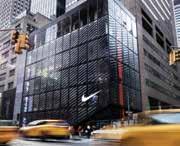
New York City-based toy retailer CAMP has created such immersive and entertaining experiences in their stores that, in many cases, consumers are paying an admission to just take part in them. In fact, powerhouse brands from Disney to Nike have recently engaged CAMP to mount branded experiences in their retail stores. In essence, the experience at CAMP has become the product.
We live in the age of peak product. Amazon, for example, offers more than 500 million products, the vast majority of which can be on the consumer’s doorstep in a day or two. And Amazon is only one Goliath in a market saturated with buying options. The brutal reality today is that for most retailers, product, price and promotion are no longer stable footholds from which to compete.
Ultimately, the only remaining distinction between one retailer and another is the customer experience. Put a different way, in the age of unmitigated consumer choice, the experience of buying the product has become the product itself. A growing number of enlightened brands, therefore, are putting every aspect of the customer’s journey under the microscope to ensure that each consumer/brand interaction is not merely acceptable but delightful, memorable and worth talking about. Retailers who fail to observe this trend do so at their peril.

A pioneering example of universal design can be seen in the inclusive space Starbucks Korea (right) has created for customers and employees with a wide range of abilities. Employees are equipped with digital tablets to facilitate communication with customers. The store floor, back room and bar have all been designed in collaboration with members of the disability community to better optimize the space for using mobility aids. Other features include a dual-monitor POS that shows customers their order, contactless speech-to-text voice recognition through a tablet at the register, Braille menus and tactile signs to navigate the store.
UK supermarket giant Asda implemented new tech last September to make it easier for blind and partially sighted customers to navigate stores. Incorporating the smartphone app GoodMaps, user location
Katie Baron, Content Director, Trends, Stylus, cautions retailers to think about users of all abilities.
is mapped throughout the store and the app can communicate directions to product aisles or store areas via audio, enlarged visuals and touch commands. Shoppers can also search for key landmarks within the store such as the pharmacy, toilets and tills

In 2022, US retail corporation CVS launched Spoken RX (below left), the first in-app prescription reader to be developed by a national retail pharmacy. The labels are scanned using the Spoken RX tab in the CVS app and important prescription information is read out loud for the customer, removing barriers to healthcare for all patients.
Danish beauty brand Comme Deux allows online users to adjust their website viewing experience with preference settings to turn on options such as “seizure-safe profile,” “ADHD-friendly profile” and “cognitive disability profile.”
The next decade will make it a moral and commercial imperative for retailers to service and empower consumers of all abilities (physical, mental and sensory) within the same spaces, both physical and digital, and without silos. We call this “universal brandscapes.”
It’s a liberation missive for every part of the brand ecosystem when you consider that approximately 16% of people globally live with a disability, yet under 1% of primetime TV ads show that reality, and 43% of people with a condition have abandoned purchases online due to poor accessibility.
This response means representation from the adverts we’re served to the virtual worlds where we’ll self-represent. It’ll also mean UX – from specialist filters, overlays and coding recalibrating e-commerce in a nanosecond for conditions as diverse as dyslexia and Parkinson’s, to image-recognizing and multisensory tech retrofitting physical spaces so they can be navigated in a number of ways.
Why is this imperative long-term? As the awareness and diagnoses of neurodiversity rises, we will see a much greater consumer demand for brand initiatives that accommodate a far greater number of personal nuances. Similarly, aging populations and a focus on how retail supports older citizens or those moving through life changes will hit the top of consumers’ agendas.
We might have seen a cooling off from brands this year as fears of recession and inflationary pressures bite into budgets, but make no mistake, the metaverse (a.k.a. always on, communally accessible, interactive virtual worlds) is the next phase of the internet, and certainly the future of e-commerce. When faced with the promise of ultraimaginative discovery and technologies that make virtual worlds as sensorially extravagant as “real” life, the old school e-commerce “grid” will look more than tired.
To date, most brands have focused predominantly on the gamification for entertainment in these virtual spaces, not yet looking to their capacity for indulging the growing desire for better well-being, learning, solace and self-expression, smaller forms of social media, and the possibilities afforded by co-presence (spending time with someone virtually, wherever they are in geographical terms).
As avatars become as popular as the “real” thing, digital products cement our online personas and virtual homes start to offer expanded opportunities for retailers. Interoperability – the capacity to leap between worlds – will drive adoption, too.
This won’t only affect retailers’ digital spaces, but also retail flagships as they become vital gateways in inviting the curious and/or uninitiated into their Web3 worlds.
With climate crisis looming ever larger, we are officially in the age of non-abundance. This doesn’t mean that newness won’t matter, but that the next five to 10 years will mean retailers radically reimagine how they instigate that sparking of fresh joy.
Resales will need to become part of every retailer’s agenda – a grand marketplace of the fabulous pre-loved. It’s a consideration most keenly evidenced in fashion so far, but which will spread to every sector. For e-tail, new hassle-free automated reselling tech (using swing tags and apps and even in some instances the instant creation of localized ads) will offer retailers key wins.
Top: Working with leading makeup artists, Clinique launched the “Metaverse More Like Us” campaign to challenge unrealistic beauty standards. Above and right: Legendary Paris fashion destination Galeries Lafayette launched (RE)Store, an entire floor dedicated to second-hand and responsible fashion.
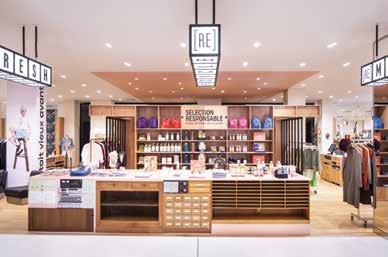


Store environments, too, will be reshaped by service propositions that put circularity front and centre on the shop floor, including swaps shops and borrowing stores (for everything from podcasting kits to furniture). The latter strategy in particular will boom across the next five years, as consumers seek new ways to cut costs.
Helping consumers to help themselves will underpin this shift. For luxury brands this will manifest an uptick in consumers seeking eco-concierges that look beyond the old school prestige of “brand new” to signal their climate conscious values, and to retailers that can demonstrate a commitment to creating abundance from scarcity, focusing on sustainably regenerating resources.

Mixed-use communities and 15-minute cities that integrate residential, commercial and retail spaces within walking distance will create more vibrant and dynamic retail environments. The pandemic has accelerated this trend impacting the future of retail. Curating retail and the convenience of having shopping and services nearby encourages the residents of these communities to shop locally and more frequently, leading to increased foot traffic and sales.
In addition, 15-minute cities prioritize walkability, biking and public transportation, which further promotes local retail and reduces reliance on cars. This communitybased living will lead to the resurgence of third spaces, like cafés, libraries and community centres, which act and serve as social hubs for residents, particularly as the residential element in these communities tend to be smaller. Furthermore, the emphasis on sustainability and community-building can attract socially conscious consumers that prioritize shopping with environmentally and socially responsible retailers.
The question will be whether retailers will have developed their own AI in house, or buy into whatever the evolutions of Bard or OpenAI’s products become. The changes will be momentous, from unheard-of levels of personalization and product recommendation, high-level engagement mapping both online and in store, and the cost savings that can be seen though predictive pricing to supply chain innovations.
The world’s urban areas will more than double in size by 2030. Two-thirds of all Canadians will live in an urban area. This will fundamentally impact the ability to access physical retail, and change the nature of stores altogether. Already we are seeing stores becoming community hubs, repurposed to provide experiences beyond their standard intent. This trend will have a negative impact on rural populations, at times already underserved and overpriced, as there will be increased supply chain pressures to serve those areas.

Gen A is the demographic cohort commencing in 2010. Although still young, they are already shaping the future of retail. They’ve grown up with technology being an integral part of their daily life. These digital natives expect seamless and personalized experiences across all channels. They are passionate about sustainability and social responsibility, which will force retailers to prioritize ethical and environmentally conscious practices.


In 2022, Statistics Canada reported that 19% of Canada’s population will be age 65 years or older. They forecast continued increase, reaching 23% in 2030 – that’s nearly one in four of all Canadians. This will impact everything from store design and navigation, lighting, e-commerce UX and product assortment and innovation. Canadian seniors historically have a larger net worth and spending power, and retail will need to keep up to keep whole.
 Jason Dubroy, SVP, commerce and experience, Mosaic, has his eyes on Boomers and AI.
Jason Dubroy, SVP, commerce and experience, Mosaic, has his eyes on Boomers and AI.
Right: Petco says its pilot recycling program could divert nearly 864,000 pounds of plastic waste from landfill.
Below: Author Paco Underhill sees retail shifting to become far more convenient.
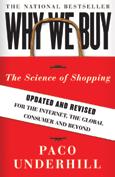
Bottom Right: Vision Greens recently raised $7 million in growth capital to expand operations.
With the one-two punch of the pandemic and the climate crisis – actually, three, if you count the war in Ukraine – consumers have become all too familiar with occasionally empty shelves in stores. So, in a future that might feature limited access to the goods we’ve come to rely on, how will retailers need to respond?
“Some of the issues of scarcity [will have to be addressed by] merchants who recognize that supply chains are in transition,” say Paco Underhill, founder and strategic advisor of Envirosell Global and KP Ecological, and author of books such as How We Eat and Why We Buy. “For example, Loblaws could be growing much of the greens it serves in the context of the location, either in the parking lot or the rooftop with hydroponic growth.”
The case for going local is sure to become much clearer as the supply chain tightens. In the throes of the pandemic, consumers supported local businesses while the need for vaccines and N95 masks exposed weaknesses of a system where
goods are produced abroad. Canada, for example, is the largest producer of mustard seed… yet we don’t produce mustard. While mustard won’t be priority in a time of scarcity, strategic considerations will need to be made for those items that are.
Naturally, companies have already begun stepping up. One example: Vision Greens, based in Welland, Ontario, is using hydroponic technology to grow lettuce via indoor vertical farming in hopes of reducing dependency on produce from the U.S.

Retail and consumer experts agree that growing consumer awareness of energy, carbon and water issues – as well as a new Canadian law to prevent forced labour and child labour within supply chains –may also translate into the need for more information provided on packaging and by retailers in general.
“Being customer-centric means being transparent, and the more transparency you can provide your customer, the higher level of trust you’re going to build with them,” says Myles Gooding, national consumer markets leader and global consumer markets advisory
leader with PwC Canada. “Building trust is going to be part of the future business currency of growth and growing your customer base. Those that don’t do that will eventually fall by the wayside.”

For example, Gooding points to how shoppers who encounter empty shelves in place of their usual romaine lettuce aren’t typically provided any information as to why it’s not available. They’re often left to search online for the reason (which is likely due to a climate, flooding or E. coli issue). A jar of tomato sauce may indicate it is “Made in Italy,” but better transparency might reveal the tomatoes are harvested somewhere else under questionable labour standards, and that is now impacting supply.
Gooding suggests many businesses tend not to act until there’s pressure from government regulations. So, forward-thinking companies and retailers should start to think (and talk) about where components are sourced, how the product is processed and how sustainable the product is.
But how brands communicate to consumers will be just as important. People tend to tune out stories they’ve heard too many times – especially when it feels like there’s more talk than action. “You may not be able to talk about carbon because it feels very political. So, you might talk about soil health instead,” advises Sherry Frey, VP of total wellness for NIQ. “It’s a little bit – probably unfortunately – of a dance.”
Retailers may also need to rethink the physical set-up of their stores as supply becomes unreliable. Frey sees a future in which layouts are centred around routine and high-repeat purchases. “The store becomes more a fulfillment centre versus a store for actual impulse buys,” she says. “As retailers want to draw consumers more into the store, if they move towards the fulfillment area, the rest of the store has to be more experiential.”
Store layouts may be reimagined in other ways, too. Says Underhill, “We worked with a Brazilian company where they would assemble in different parts of their store all of the related material. So, for example, an allergy store, and all of the products from clothing to food to medicine that would be spread out across the store would be concentrated all in one place, knowing it was for a particular customer segment.”
Forward-thinking companies might even consider stepping up to provide innovative add-on solutions to address shortcomings in the supply chain. In the U.S., for example, Petco Health and Wellness Co. recently launched a pilot recycling program where its store operations and customers can deposit items such as non-curbside waste and pet food packaging at its stores, which, through a partnership with decking company Trex, are then converted into composite decking material for commercial and residential use.
Data and privacy have been foremost on the minds of the industry, and it’s not just because of innovation. The space is one undergoing massive change, be it because of new regulations (including Bill C-27 at the federal level, as well as Quebec’s Law 25 and British Columbia’s Bill 22) or the pending death of cookies transforming how ad targeting works at the most basic level. This, of course, requires a lot of innovation to adapt, be it entirely new targeting methods or concepts like synthetic data and clean rooms to manage data and find insights in a privacy-safe way. But it is also leading many brands to rethink how they’ve used data in the past, and if there isn’t a better and more rewarding way to put that info to use.
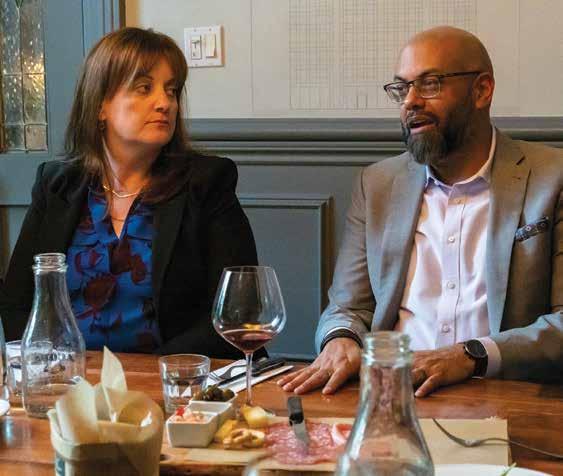
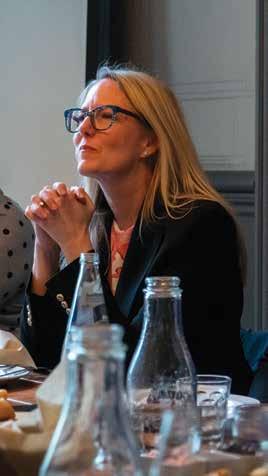
The dust is far from settled, but those in the know have been thinking and testing and working on new solutions for long enough to provide their insights on what to expect. Strategy recently gathered a group of marketers and media agency execs to consider the challenges and opportunities to be found in this new dataand privacy-first world.
MODERATED BY JOSH KOLM, EDITED BY CHELSEA CLARKEThe big looming change to how advertisers use data is cookie phase-out. Having seen and tested a lot of the post-cookie options, do you have any major concerns?
Gautham Pingal, EVP, performance and innovation, EssenceMediacom: I’ve made peace with the fact that this is going to be ambiguous for a while. Initially, we were waiting for the market to step up with more identifying solutions, but it moved at a snail’s pace, so we’ve started testing out different concepts by ourselves. I wish there was a more structured approach, and more time and options. We seem to be doing it like a bit of an underground project and waiting for someone to come and tell us, “This is probably the better way to do it.”
Derek Bhopalsingh, EVP, platform media, Publicis Media: At first, everyone had their foot down on the pedal, and then it got delayed, delayed again, delayed again. So everyone has taken their foot off the gas, which isn’t the right thing to do. One of the biggest challenges you’ve also had is a lack of consistency. It’s not as much about performance as it is our ability to measure and understand that performance. We’re seeing massive deltas, and for a lot of our marketers, those deltas aren’t acceptable, because they’re not able to quantify the return on investment. There’s not enough aggressiveness in the market, especially within Canada, to really nail down solutions.
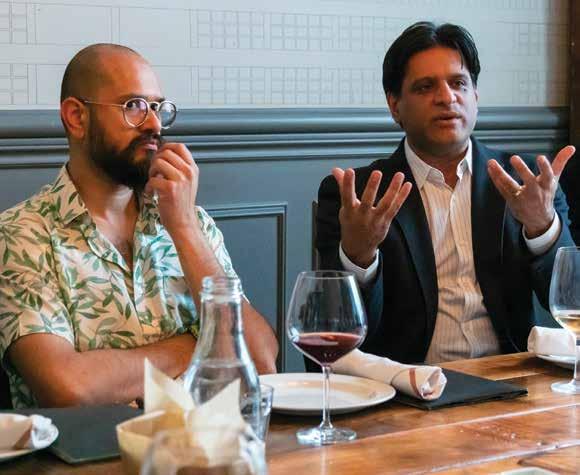
Christine Smith, director of marketing, Hyundai Canada: We have the added wrinkle in automotive of exceptionally low inventory, so our low funnel is a little screwed up right now and doesn’t convert the
same way. Sometimes there’s a long delay, sometimes that delay means that there’s a lack of a conversion and has nothing to do with the effectiveness of the advertising. But we’re definitely not seeing any kind of clear winners for solutions. We’re trying to keep a constant test and learn because we do know that we are going to have to completely recalculate all of our KPIs. If you have a year-over-year drop all of sudden, you’re going to have to explain it.
Emma Eriksson, VP of marketing and wellbeing, Kellogg Company: A lot of CPGs are still in the initial phases of really figuring out how to leverage data in the best possible way. We’re still building our use cases for future sales, so we have been focused on gathering more high-quality first-party data and doing a bunch of testing to add value to our targeting, retargeting
and personalization. We don’t have the problems of having to reexamine established KPIs because we are still building for the new world.
Bhopalsingh: Hey, that puts you ahead of a lot of people...
Cookies aside, are any of the proposed solutions bringing any benefits you had been hoping for anyway?
Brian Cuddy, SVP, responsible media solutions, Cossette Media: Caring about the content is a big one that we lost in the digital attribution era. Targeting anyone at the cheapest cost you can possibly pay has resulted in a lot of problems. I think going back to smarter models that use algorithmic approaches to measurement will also show what’s more influential, and take some of that spend away from more nefarious places.

Smith: It’s added rocket fuel to our desire to integrate our data more effectively. We’ll probably place our biggest bet on a firstparty data model, but we have limitations there. We exist in a bit
who our audience is. We can look at different methods of understanding where those audiences might be. But we don’t get the final sales data. We can only lead customers to the gate and leave it open. So we’re giving customers tools that will help them enjoy the RVing lifestyle so they’re informed when they get to the dealer, and that data is coming to us. We do have a digital agency, and we’re trying to get them to practice with things that will let us be more economical with spending. Because with all these new technologies emerging, the cost of advertising is going up.
Pingal: That’s my concern: is this going to add costs to what
moved away from presenting all these different data sources that can’t be actualized, to putting the use case up front, which shows us a much simpler way to use that data. It also means clients don’t just come to us looking for sales, because sometimes the use case is organic brand or search keyword lift.
Are there ways data can be used in ways that aren’t just a ruthless pursuit of efficiency?
Pingal: I had a colleague summarize this as “how did we get so much more data and so much more stupid?”
Bhopalsingh: Short-termism is even more of a problem coming out of the pandemic, because we’ve got to recoup what we lost, and then we’re into further economic downturn. It’s created this hyper focus that we saw in and after 2008. Folks forget this when costs rise and they’re not seeing conversions, but in every economic downturn, consumers are more open to brand switching and incentives. So many brands die during these downturns because they’re so focused on short-termism. Yes, you have to keep running a business, but there needs to be a balance between short-term sales goals with driving that reason to believe, especially in an economic downturn where consumers aren’t as loyal as they used to be.
of a fragmented data pool. We’ve got our own data, but also dealers, franchisees, telematics data that’s in the car. Who does that belong to and how can we bring it all together?
Cyrus Irani, director of digital strategy, Go RVing: We’re in a similar position because we are a marketing arm. The benefit is we can test against predictive models, because we know

I’m already doing? Is this data, viewability and solution layer going to be another incremental cost that we need to eat within our marketing budget to get more efficiency? I keep thinking to myself: at what point is this going to stop? What I’m finding really interesting, and what we’re telling our clients, is that there’s just too much data noise out there, so let’s prioritize use cases. We’ve
Smith: What’s the old adage? ‘There’s nothing like a crisis to give you an opportunity’? One blessing of supply chain challenges is that it allowed us to shift our approach. Instead of optimizing our media into a corner, we could turn our attention to optimizing creative. We’re following sales-oriented KPIs, but also brand metrics and connecting that to the activities we’re doing. At some point we’re not going to be able to make our systems any smarter, so we had to open the aperture on what we
“I THINK GOING BACK TO SMARTER MODELS THAT USE ALGORITHMIC APPROACHES TO MEASUREMENT WILL ALSO SHOW WHAT’S MORE INFLUENTIAL, AND TAKE SOME OF THAT SPEND AWAY FROM MORE NEFARIOUS PLACES.” - Brian CuddyCuddy, Pingal and Irani consider future data pitfalls and opportunities, as Globe and Mail CRO Andrew Saunders (far left) looks on.



The Canadian media landscape is continuously evolving, and uncertainty has become part of every marketer’s daily reality. But in periods of significant change, there are always opportunities. That’s why at Globe Media Group, we are proud to sponsor this roundtable series. These forums unite industry visionaries and experts to illuminate the way forward through challenging times, helping us to envision a future we can be excited about.
Our change-making content can help you to reach ambitious Canadians making an impact.
That’s leadership you can count on.
Globe Media Group is proud to partner with strategy in driving influential conversations around media in Canada. Stay connected at globelink.ca
Where ambition meets influence.
were optimizing. And because of removing cookies, it is going to get dumber, so we needed to find other ways to move the needle, and be the ones who were smarter.
Eriksson: I do think it’s very intoxicating, this drive of being able to measure everything. One thing I feel good about being a little old school is that we measure brand equity, brand power, we look at the whole funnel, as well as marketing mix modeling. The emotional connection and brand building is
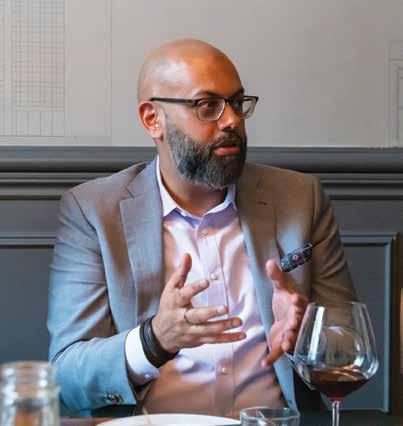
not just nice to have. When we look at our marketing mix modeling, that is still the highest ROI, especially if you can stretch it out over a masterbrand type of approach.
Irani: The metrics only get you to a certain point. For us, the data is about recalibrating the brand and almost mapping the demographic shift that’s happening. Our core demographic is younger than all of us in this room, but they’re still emerging into the lifestyle, so our advertising is being used to target those demographics more intensely to bring them in a few years from now. Everyone wants success every year, but we have to play a longer game because it’s a longer term purchase.
Are there any new tools, capabilities or concepts out there that you find particularly exciting when it comes to the goals you’re talking about?
Cuddy: I’m excited about synthetic data for training and understanding. Thinking about how you can leverage algorithms to drive decisioning and connections in a very direct but automated way in the CPG and retail media spaces is exciting. But I think the really interesting part is: how do you get that into big platforms to start to really leverage the investments they make in their systems, which I don’t think Google or Facebook have much incentive to allow. If you think about the role Google plays in all of this, it’s hard to overlook what their incentives are.
Bhopalsingh: That’s one of the big challenges with all of these models, interoperability. I love what’s being done with synthetic data and the investment that’s gone into building some of these models, but we’re finding they don’t necessarily work with our ways of buying media. It’s worth the discussion at a very high level to see how different methodologies would work for your organization, but I would be careful of folks coming in with different tools to help cover how that’s applied. It’s still early days and it’ll get to that 95% or 100% accuracy, but models are only as good as the data going into it. And that’s the other issue in Canada: we’re data poor. You find the more robust data sets out there, for the time being, are probabilistic.
Is Canada data poor because of its population, or its ability to scale?
Bhopalsingh: Maybe that’s a dangerous term. Because Canada never gets the credit it deserves for protecting the privacy of consumers. PIPEDA and CASL were leading legislation, globally, at the time they were introduced. It protected Canadian consumers from things other markets struggle with, and that’s a good thing. So maybe I’ll rephrase it from “data poor” to “being more
“I LOVE WHAT’S BEING DONE WITH SYNTHETIC DATA AND THE INVESTMENT THAT’S GONE INTO BUILDING SOME OF THESE MODELS, BUT WE’RE FINDING THEY DON’T NECESSARILY WORK WITH OUR WAYS OF BUYING MEDIA.”
- Derek Bhopalsingh
Find all the advertising choices that fit your brand’s criteria + relevant rates and target audience planning data. Subscribe at cardonline.ca for all your media buying and planning intel needs.
CARDonline is powered by strategy news for added context on Canada’s top media companies and their offerings.














challenging for marketers to have the same ability to get one-to-one connections as they would in other markets.”
So are there any big “data gaps”?
Eriksson: A lot of options are still very U.S.-centric. They have the scale to put lots of money into buying data sets and marrying that with first-party and transactional data, and a lot of systems are based on that. That doesn’t work in Canada. We always have to build our own solutions that are more pragmatic and can
it’s going to be more difficult when things like generative AI come to the market.
What kind of onus do advertisers have to respect consumers’ privacy concerns, even if they aren’t being mandated to by law?
Cuddy: You should want to do it, not just because it’s the right thing to do but also because you don’t want to waste a ton of money building towards a privacy standard that’s going to change. Providing tangible value in exchange for access to data is where everything is going, and it is almost a personal relationship.
do. The funnel might start smaller, but you bring more people through.
Pingal: We also keep waiting for legislatures to pass laws, when we are the ones in the thick of it. I believe advertising has a conscience, and there is an opportunity for us to define what is ethically right earlier on. We’re not great at moving early, when you look at drawing measurement standards, we still debate about what is an integrated measurement standard across channels. But if we can get away from that when it comes to using data, we can also drive more consumer confidence and break the perception that all advertisers are evil.
Cuddy: That’s kind of where we came from with the [CMDC’s] Canadian Media Manifesto. Recognizing that Canadian media is important and it is a big reason an ad-supported internet exists, but we need to understand the impact a quality advertising approach can have.
scale here. And we don’t want to buy into all these big expensive tech stacks if we’re not going to get the same performance out of it.
Looking at data in Canada right now means also considering the impact of new privacy regulations. Is there anything in the regulatory landscape you see as cause for concern?
Bhopalsingh: The federal government should not rely on Quebec to lead the way. In the U.S., you have five or six states with their own privacy laws, and the IAB is working on a lowest common denominator approach for organizations to operate in a privacycompliant way across all of them. We need to stay away from that if we’re going to be effective. The onus is on the federal government to stay abreast of what’s happening and not let the provinces take the lead. They’ve struggled to keep pace, and
It makes buying all this one-to-one, stitched-together data and putting it into a big platform, reselling it and making margins on every programmatic exchange ethically wrong.
Smith: It’s a quality versus quantity thing too. If you think about how you are going to move the needle on your KPIs, if you are going to use your data to make the experience better and higher quality, you are going to get more people to engage and do the behaviours you want them to

What are the big ways you think new regulations could change the way that brands and their agencies work?
Bhopalsingh: The bill tries to take the best of GDPR and CCPA, so a lot of us at bigger agencies have been operating in a way that’s compliant with those, and you won’t see a big change. The bigger change you’re going to see is in the Quebec marketplace.
Pingal: But we will need some conversation about what is and is not personally identifiable information. For me it feels like the question is constant, and we’ll need some level of standardization.
Cuddy: I’m wondering if that, plus cracking down on third-party data providers, then provides more value to originators of the data, like publishers. It may provide more incentives for direct relationships.
“WE’RE DEFINITELY NOT SEEING ANY KIND OF CLEAR WINNERS FOR SOLUTIONS. WE’RE TRYING TO KEEP A CONSTANT TEST AND LEARN BECAUSE WE DO KNOW THAT WE ARE GOING TO HAVE TO COMPLETELY RECALCULATE ALL OF OUR KPIS. ” - Christine Smith


 BY SHEIMA BENEMBAREK
BY SHEIMA BENEMBAREK
“Try the product! We have a taste advantage.” If you happen to be an avid Coke drinker and you come across Sassan Jahan at a party, that’s what he would tell you to turn you on to Pepsi. That is, if you pushed him to. The PepsiCo Canada CMO respects different preferences but, he repeats with a growing smile, Pepsi definitely tastes great. And for him and his branding team, it’s just that simple.
Protecting the soft drink’s legacy, staying relevant and truly Canadian are key to the brand’s enduring success, he notes. “We’ve inherently been very Canadian in everything we do. We’re Canadian marketers marketing to Canadian consumers.”
The branding, explains Jahan – who has been with PepsiCo for almost 24 years – has always been fuelled by the commitment it takes to deliver Pepsi consumers exactly what they’re looking for when they reach for that universally recognizable can. But the marketing team is also aware that they are custodians of a brand that’s both timely and timeless.

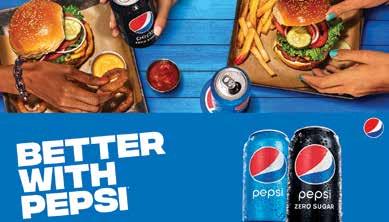
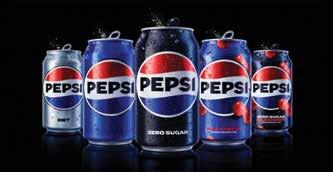

“Our job is to protect [the brand] and then build on the foundation that was created and maintained,” he says. “Our responsibility is to make sure we pass it on in a great state to the next generation of marketers.”
To that end, Pepsi is launching a new logo and visual identity this fall to coincide with its global 125th anniversary – an identity that continues to be “unapologetically current and undeniably Pepsi.” The refreshed and updated branding will have bold type, an energetic palette and a unified logomark. Says
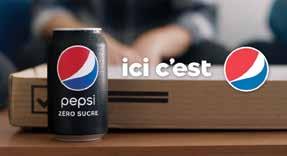
THOUGH PEPSI IS A BRAND THAT BELONGS TO THE ENTIRE WORLD, HERE AT HOME IT REMAINS RESOLUTELY CANADIAN.
Above (top row): Pepsi’s original HQ in Montreal – the brand still dominates the Quebec market; Pepsi celebrates World Emoji Day; Pepsi partnered with Pulplex to create the world’s first 100% recyclable paper bottle; Pepsi Blue was a limited-edition roll-out for Canada and the U.S. (second row): the brand updates its logo and design for 2023 – and rolls out a new campaign: “Better with Pepsi”; Sassan Jahan, PepsiCo Canada CMO.
Right: The Pepsi logo has evolved over the years, but it always remains familiar.
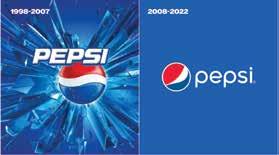
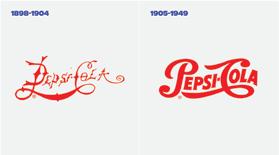
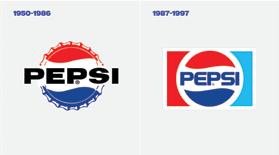
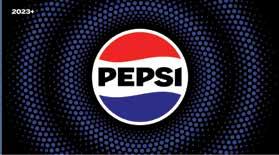
Jahan: “Holistically, the new look is a bold leap for the brand. Among the key updates is the addition of the colour black, an ode to Pepsi Zero Sugar.”

The rebrand work was completed by the PepsiCo design and innovation team and will be launched in phases – in North America in 2023, followed by global markets in 2024. “You’ll start seeing the new look on packaging, but the signage and equipment at individual retailers or foodservice locations may transition more slowly as they exhaust their current Pepsi inventory and collateral.”
Looking back at the iconic campaigns the brand has deployed over the years, the upcoming refresh feels at home. Jahan describes it as an initiative that builds on the strengths and distinctiveness of the brand’s history.
Who can forget the 1992 television spot with a beautiful Cindy Crawford in daisy duke shorts satiating her thirst with a can of Pepsi? Or when the Spice Girls brought a whole generation of bubbly young girls into the Pepsi family with the “Generation Next” commercial? If you’ve grown up drinking Pepsi, the change will seem a natural extension of what’s come before.
There is buzz about the launch – probably because of the brand’s legacy of culturally relevant advertising. The most recent of these took place in 2015. The “Say It with Pepsi” campaign took the increasingly popular construct of emojis as a marketing tool devised to inject the brand with more personality.
“As a brand recognized for being on the leading edge of pop culture, we were proud to step into the world of emojis and give consumers a unique and fun way to express themselves,” Jahan notes. In addition, Pepsi Canada rolled out a custom #PepsiMoji keyboard featuring 60 emojis, including new ones that research suggested Canadians wanted – a selfie, a taco and a hockey emoji. Succeeding in the cultural sphere in a uniquely Canadian way like this propelled the campaign into a global release.
Though a leading national brand, domestically the beverage has always had a stronghold on Quebecers’ hearts. And with good reason. Pepsi Canada, which turns 90-years-old next year, began in Montreal with the opening of a bottling plant on June 12, 1934. The work the brand has done and continues to do in the francophone province, along with the deep-rooted history it’s built there, is a big source of pride.
In the 1980s, Pepsi partnered with beloved actor Claude Meunier for a series of television advertisements that Quebecers appreciated. “That work that was done for almost 20 years made Pepsi the first brand to commit to Quebec-only advertising,” says Jahan, “It’s phenomenal.” Even to this day, Pepsi wins over Coca-Cola in popularity there.
Pepsi has always found a way to be culturally resonant to Canadian consumers.
Pepsi has always found a way to be culturally resonant to Canadian consumers. Consider the “Forever Young” campaign that came out in the early aughts and encouraged a move from regular Pepsi to Diet Pepsi.

“It was created in Canada and it was really relevant,” shares Jahan. The ad features Bob Dylan imagery and Will.i.am belting out two different versions of the iconic Alphaville song with the understanding that every new generation refreshes the last’s innovations.
“This is work that is not lifted or adapted from amazing work that is created by our global team – these are done
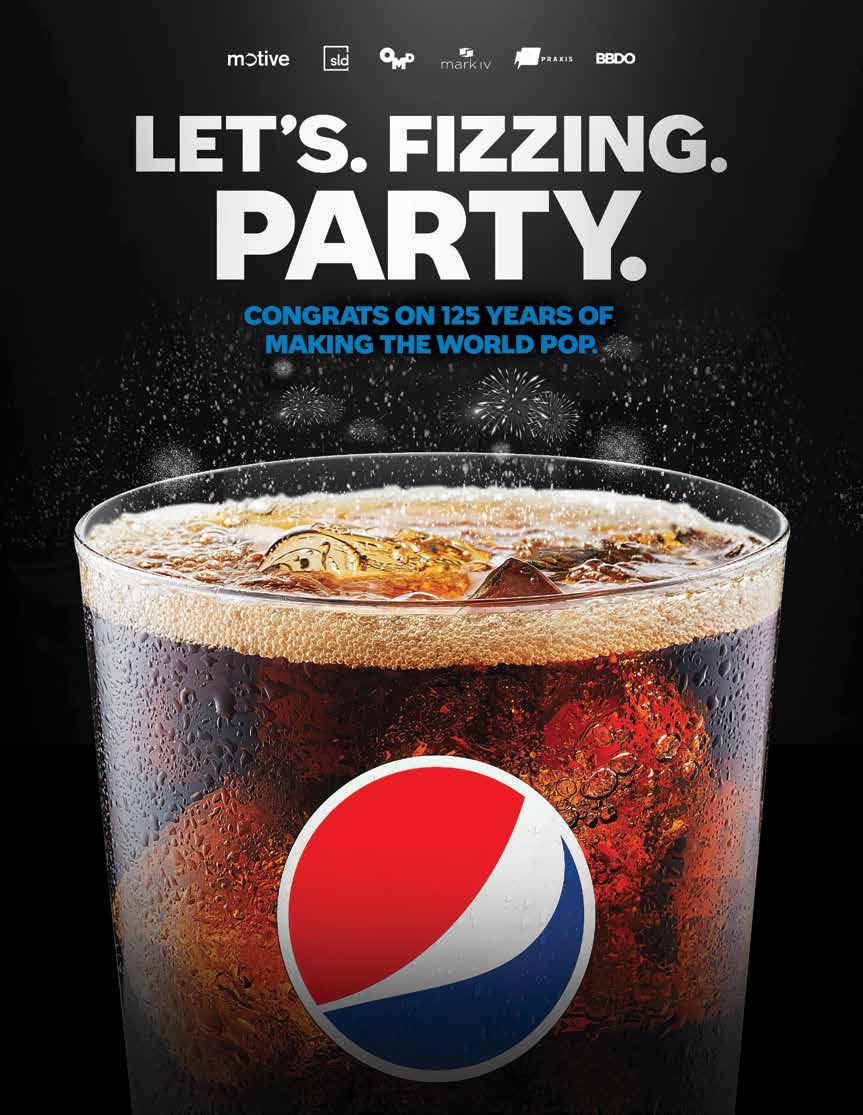
in Canada,” Jahan highlights, “And that’s what I’m most proud of.”
But don’t ask him which campaign is his all-time favourite, because he answers the way parents do: I love all my kids equally. What he is able to confirm is that for him and the Canadian Pepsi brand team, as long as consumers enjoy what they deploy, that’s all that truly matters.

In terms of whether the work they produce is done in Canada or in the global in-house content studio in New York, Jahan explains that it really depends on the nature of the campaign. If it’s an initiative that’s geared towards Quebec, for example, it will be made here in collaboration with the likes of BBDO Canada, PRAXIS, OMD, Motive, MarkIV and Shikatani Lacroix Design. Others, like some of their hockey pieces, were produced in the U.S. The rule of thumb is: where it makes sense they use Canadian agencies, and when it makes sense to rely on the global in-house content studio, that’s what they do.
It’s also critical to keep up with the changing nature of consumers, be it due to generational or social developments. “We invest in insights to make sure that we’re aware of what the consumers are looking for. It’s made us consistently reinvent ourselves and evolve with them.”
For instance, in the last few years society has been slowly shifting towards sugar-free, and Pepsi Zero Sugar became the answer to that challenge. Jahan believes that what helps keep them centre stage culturally is that they always tap into Canadian passion points when it comes to sports, entertainment and music preferences – a throw to their latest ad campaign, “Better With Pepsi.”
“The good thing is: we’re global. We’re available in more than 200 countries, and the brand stands for the same purpose everywhere. So whether you’re from Morocco or I’m from Iran, our association with the brand is similar,” Jahan explains. It means there isn’t too much of a need to reinvent the wheel for newcomers – the current national marketing strategy taps into a distinguishable taste and look that includes all of us.
“We have a robust innovation pipeline that is continuously delivering. I could not be more optimistic about the future of PepsiCo.”

Cheddar Cheese – flavours such as Ketchup, Pizza and most recently Sour Cream & Onion.
How has the brand stayed relevant?
The Cheetos consumer is always evolving and we’ve gone to great lengths to understand our consumer needs and show up for them in a way that is both fun and culturally relevant. Originally, we leaned on the brand’s mascot, Chester Cheetah, and were really geared towards family fun. However, only 22% of households that purchase Cheetos have kids, signalling a huge untapped opportunity for the brand to increase relevance and awareness with a broader set of adult consumers.
From the Cheetos Mouse to Chester, and slogans like “Cheese that Goes Crunch” to “Dangerously Cheesy”, Cheetos positioning has gotten bolder since the snack first launched in 1948. So, we wanted to know what’s in the Cheetos DNA that makes it so adventurous. strategy sat down with Jess Spaulding, CMO of PepsiCo Foods Canada, to get the scoop.
What is it about this brand that always makes it want to try new things?
The Cheetos brand is wired for fun and experimentation. We’re driven by our ambition to be more than just a delicious cheesy snack – we are a brand rooted in culture. You can see this through the evolution of our taglines. Both “Cheese that goes Crunch” and “Dangerously Cheesy” represented very functional aspects of the brand. Our new positioning “It’s a Cheetos Thing” speaks to the distinctive brand attributes that make Cheetos so playfully mischievous and unique, and it amplifies the “insider” knowledge. It’s a way to explain the unspoken bond our fans share; the people who get it.
For our fans, Cheetos isn’t just a snack, it’s a part of their life. And it’s this very insight that makes us want to push the boundaries and be daringly mischievous. We’ve seen that in the success of our new flavours that go beyond just
We made the shift to expand our target to the people who believe there’s always an opportunity to shake things up. Our goal is to fuel this fandom and build Cheetos into a brand inspired by its biggest fans. We’re always looking for new ways to engage, which is how we developed our recent Cheetle in Cheadle program.
In leaning into the very thing that makes Cheetos distinctly Cheetos – the distinctive orange dust – we decided to build a monument in celebration of it. The 17-foot statue of Cheetle covered fingers, dropped “anonymously” in Cheadle, Alberta is the kind of thing our cult goes crazy for. In fact, it had our fans talking about it in 28 different countries across the globe.
So, how do you get the tone right?
We target all Canadians with a similar mindset; adults that stay young at heart and don’t subscribe to the conventional definition of what it means to be a grown up. For us, this meant that we wanted to move away from speaking only to the functionality of our brand, to positioning our brand within culture and within the lives of consumers.
We know our fans are hungry to find new ways to interact with this delicious snack icon, so we push ourselves to think up culturally relevant ways that will speak to them.













To everyone who has been part of SickKids VS: you weren’t just working on an ad campaign.Roux, age 3 Norah, age 5 Tahcari, age 6
Thank you all: Cossette, OMD, Scouts Honour, Skin & Bones, The Vanity, Rajakovic Electric, SNDWRX, Citizen Relations, Strategic Navigator, Undivided, No Fixed Address, Outsider Editorial, Alter Ego, Nimiopere, The Deli, and countless others.

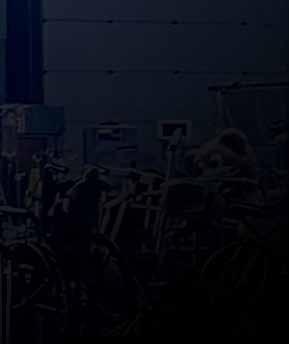







Over the last six years, we would never have seen the success we have without your art, your craft, and your dedication. You’ve created the most-noticed, cared-about, fund-raising, & award-winning campaign in Canadian healthcare advertising history. But this campaign is about so much more than that. Hold this in your heart –what you’ve helped us achieve is even bigger.




You were working on this.Roux, age 6 Norah, age 8 Tahcari, age 10

Status quo doesn’t cut it anymore. Just look at how Canada’s top brands approach marketing to see how much has changed.
But how to achieve that next level? This year’s A-List – a cross-section of agencies that have proven their creativity and innovation strength on the awards circuit –show how advertising can have a meaningful impact on the world, while building brand equity and business.


roles. Stephanie Yung became chief design officer, Brian Murray was named CCO, and Robyn Morrissey and Jessica Hill were appointed managing directors. Cannes Grand Prix-winning CCO Jenny Glover was recruited from Juniper Park/TBWA and Jam3 VP Leslie Uy joined as managing director of their content and innovation studio Zulubot.
The agency added high-profile accounts including Sephora and the Art Gallery of Ontario, which picked ZAK to lead its brand reinvention. Booking.com was another huge win, coming with the New York office launch. They kicked off the collab with a global platform that launched with an epic musical spot during Super Bowl LVII starring Melissa McCarthy. Not only was the assignment a first for a Canadian independent, but it was also the most-watched Super Bowl spot on YouTube, racking up over 118,000,000 views.
Mroueh explains that the project was the culmination of the combined efforts of all three offices. “We operate as one, borderless creative family,” he notes. “Our mission is to have all our offices support each other to deliver innovative, purpose-built ideas for any client, in any location.”
CONSUMERS AREN’T MAKING it easy. As they find new ways to explore and discover media, marketers have to work harder to stay one step ahead – as do their agency partners. Which is why since its launch in 2008, Zulu Alpha Kilo hasn’t stopped reaching for that next level.
“Part of our founding DNA is to constantly be reinventing ourselves,” says agency founder and creative chairman Zak Mroueh. “To achieve this, we have to always be looking forward, embracing change, and living our values.”
“The word that best describes last year is “evolutionary,” according to president & CEO Mike Sutton. The shop broke through international borders, launching a New York office with ex-Droga5 CCO Tim Gordon, and headed west to hang its shingle in Vancouver with ZAK veteran and managing director David Tremblay. Out of the gate, the new office landed big local wins including AOR assignments for Save-On-Foods and Destination BC. With the arrival of Alicia Petralia, it fired up Zulumatic Media, a digital-first offering aimed at creating a stronger connection between media and creativity.
ZAK’s growth and expansion has opened up growth opportunities for its people. This past year, it made more than a dozen leadership promotions from within. Longtime strategy leads Heather Segal and Maxine Thomas were elevated to CSO
Bringing strategic insight and humanity to the work and achieving huge business goals is central to the shop’s recent work for Pizza Pizza. With inflation rising, the satirical “Fixed Rate Pizza” campaign offered customers the opportunity to “lock in” the price of an extra-large four-topping pizza as they would a mortgage. To date, it’s resulted in over 1.1 million pizzas sold. Then there’s the “Dip Roller,” a tiny paint roller that helped pizza fans spread their favourite dip and garnered over 117,000 requests for the promotional item.
While expansion is bringing new brands and talent into the fold, the agency’s core focus on building equity via brand platforms with longevity is evidenced by its long-running work for Subaru. It most recently launched “The True Urban Legend,” a campaign for the Subaru Crosstrek that treats this legendary model like a mythical beast. It “wanders the streets at night in search of food” and “lives deep in the city,” according to a trio of rural characters featured in the campaign.
With another impressive year’s worth of work, it’s no surprise the 15-year-old indie was recognized as the number-two agency in Canada on the ICA’s 2023 Creative Power List. On the WARC Effective 100, an annual ranking of the most effective agencies in the world, ZAK landed in the 13th spot globally. For the fifth year in a row, it was also named one of Canada’s Best Managed Companies by Deloitte.
So, if the goal is to consistently be evolving, Zulu Alpha Kilo is delivering on that promise. “It’s about going above and beyond to support our clients and people, and always looking in the mirror to ask ourselves how we can perform even better for them,” says Sutton.

As Zulu Alpha Kilo hits the 15 mark, evolution is the only constantAbove: Zulu Alpha Kilo teamed with Booking.com on the epic musical film “Somewhere, Anywhere” starring Melissa McCarthy. The 30-second version was the most-watched Super Bowl LVII spot on YouTube and a twominute cut ran during the Oscars broadcast.
1 DNA My Dog offers tests to help pet owners better understand the genetic make-up of their pet, including age and allergies. ZAK worked to update and refresh the brand identity with vibrant packaging that grabbed consumer attention. 2 Bell wanted a unique way to demonstrate how esports compete with traditional leagues for time and prizes. For the “Million Dollar Fingers” campaign, ZAK insured the fingers of Canada’s top Call of Duty team ahead of the Toronto Ultra Major V event. 3 ZAK worked with Harry Rosen on the launch of its Harold x You bespoke menswear line. “Sketch It Out” was dubbed the “first collab between a fashion brand and you,” and enlisted Toronto Raptor Fred VanVleet to try his own custom collab. 4 For the Subaru Crosstrek “True Urban Legend” campaign, a trio of rural characters relay apocryphal tales about the latest model. Having never seen the vehicle themselves, they share urban legends they’ve heard about this thing that “lives deep in the city” and “wanders the streets at night in search of food.” 5 ZAK’s new brand platform for Western Canada’s Save-on-Foods uses humour to capture all the unexpected benefits that come with a grocery store that gives you a little extra. 6 To highlight the unique nature of D2L’s personalized online learning platform, ZAK reimagined the standard school desk to demonstrate D2L’s belief in the power of personalized education.








Agnostic is built on the principle that better thinking drives better results. “Clients and brands want to talk about one thing, while the media wants to talk about another,” says president Sarah Crabbe. “Our job is to find that ‘Trojan horse’ insight that allows us to either start a conversation or insert ourselves into a conversation on behalf of our clients.”
To do that, the agency needed to change how it looked at storytelling and messaging. Last fall it hired Amit Shilton, formerly of the Toronto Star, layering a journalistic lens on its process. “We understand how to drive conversation and build awareness, but he understands how to make that travel in terms of the current hybrid news world that we inhabit and how we make it even more relevant,” Crabbe says.
Case in point, for retailer Metro, the team questioned the definition of “local” – an area of focus for every brand in the grocery space. It also sought to determine what issues are affecting the farming space.
The objective to increase brand awareness of the “Locally Sourced” program and drive consideration for Metro grew to include the promotion of diversity in agriculture and the goal of fostering Ontario’s next generation of farmers.
Metro’s Locally Sourced campaign with the Royal Agricultural Winter Fair (RAWF) – where BIPOC farmers spoke to attendees about urban farming – surpassed the 60% brand awareness goal, hitting 72% among RAWF attendees. Metro saw a 49% net increase in consideration and the impressions goal was surpassed by 148% with 130 traditional and social coverage pieces and 50 million impressions.
Since its inception in 2019, Agnostic has transitioned from start-up to scale-up, delivering impact-driven work for other
brands including Truss Beverages, Go RVing, Goodfood, Cisco, and consulting firm BCG. In the past two years, Agnostic has ranked in the top five for PR Agency of the Year. And its year-old focus on health is helping it make waves.
Last year it brought on Nancy Dale as SVP in charge of the agency’s burgeoning health practice. “Nancy spent 16 years with the Ontario Medical Association, and she is here because she believes there’s something different needed in the healthcare space,” Crabbe explains.
“COVID-19 changed healthcare communications forever,” she says, noting that the explosion of medical voices on digital channels is the future of that space, further cementing Agnostic’s focus on the vertical.
Crabbe attributes Agnostic’s success to talent, methodology, and its clients.
Many on Agnostic’s team – which has blossomed from two to 30 – came from larger global agencies and bring considerable experience. Climbing the ladder at multinational firms meant getting away from what they loved about the industry in the first place.
“To be back with a senior team and able to deliver counsel one-on-one, to build trust and be able to move fast with very few constraints is the beauty of being independent,” Crabbe says.
Quality versus quantity is a big part of the agency’s model as well as a strategic shift brands need to make to maximize communication plans. “Earned media has never been more coveted or more valuable,” Crabbe notes, so efforts are highly targeted. “We may tell a client we’ll get them 10 pieces of coverage that will move the needle and make a business impact, rather than 10,000 pieces of coverage just for a volume of press clippings.”
She values client trust as integral to success. “Brave clients mean brave work,” she says. She notes that successful brand building amid a shifting market reality entails an appetite for different approaches. Marketers looking to drive change benefit from the reality check and creative alternatives that come from partnering with agencies that are agile and unafraid to challenge the brief, the budget, and expected results.
“We don’t sell services, we solve problems,” Crabbe says. The agency’s approach is right there in its name: Crabbe underlines the importance of the shop not siloing itself into particular tactics, such as either earned or paid. It must remain truly agnostic.
“We identify what our clients need from a communications program: will it drive conversation, and is it the right spend in the right place at the right time? We root ourselves in strategy, build off human truths and bring work to market that drives business impact.”
1 Cheyenne Sundance, a 25-year-old self-taught urban farmer (pictured), helped educate students from underserved communities at the Royal Agricultural Winter Fair, helping Metro foster the next generation of urban farmers. 2 Cisco’s Fast Future Innovation Awards look to foster a Canadian innovation culture by providing up to $200K to solve companies’ greatest business challenges. LinkedIn was a top-performing channel for driving awareness and registration for the contest through sponsored and organic content. 3 The campaign video for the Fast Future Innovation Awards highlights Cisco’s role in driving innovation in Canada and introduced the contest to viewers in a dynamic way. 4 Menu items from Aloette Restaurant, which partnered with Goodfood on Aloette Go meal kits. Agnostic drove demand via food influencers. 5 For the launch of Truss Beverages’ THC-SAR – Canada’s first cannabis-infused Caesar – Agnostic tapped into media conversations around National Caesar Day and delivered Caesar-inspired “wake and bake” kits to Budtenders, helping Truss to continue dominating the CIB category.

CONTACT: Sarah Crabbe President scrabbe@thinkagnostic.com

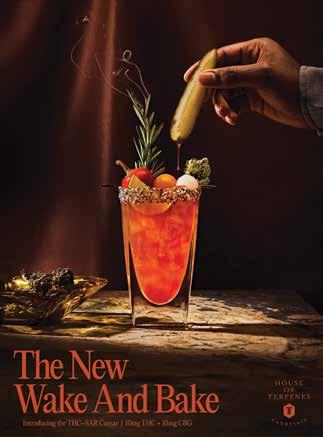
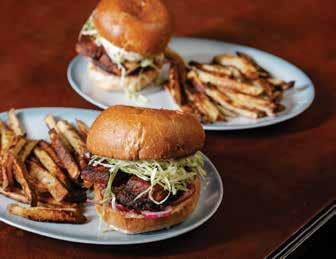

unwanted surprises but also ensures the agency is accurately capturing what the client wants to message and deliver.

True to its collaborative culture, Daughter invited TransAlta to its offices, where it displayed 40-to-50 early logo concepts on a long corkboard wall.
“We asked them to stick a note on everything that was interesting to them,” Dawes explains. Then they walked the wall again, took everything that had a sticky note on it and were asked why they liked the ones they chose.
As a result, early on in the RFP process the agency had already done a huge amount of the work and had client insight and feedback. It made some adjustments, and by the time it came to present, the prospective client already had a strong sense of ownership in the work.
DDAUGHTER CREATIVE BLENDS
design-centric thinking and campaignable ideas to help brands distill their positioning and go to market with a fresh voice aimed at winning over new audiences.

And it all hinges on collaboration that starts very early on, according to Jill Dewes, partner and director of business development at the Calgarybased agency. It’s an approach it used to score a major win for a TransAlta rebranding campaign.
The 110-year-old energy company wanted more than just a corporate rebrand. It wanted to be seen through a consumer lens.
Above: The Alberta Cancer Foundation’s 2022 Report to Our Community is told from two points of view. The printed piece can be opened two ways: one revealing an accordion of pages that tracks one person's cancer journey, alongside a business case for how donations feed into care, treatment, and research.
How did a small-but-nimble independent shop get on a multinational, corporate brand’s radar? A member of TransAlta’s team liked the rebranding campaign Daughter had done for Cabin Brewing, resonating with the mandate to come across friendlier and more human. It wanted to know how TransAlta would look through more of a consumer lens, Dewes explains.
“Someone internally asked who did the Cabin brand work, and as a result, we were invited to be part of a competitive pitch,” she says, noting that the agency has worked with other craft beer brands, including The Establishment, Annex Ale Project, and Big Rock.
Daughter maintains a confident “We got this” mien, with a critical qualifier: “‘We’ includes you.” It means bringing the client into the process from the outset – even in the RFP phase – which some aren’t necessarily comfortable with. But to the Daughter team it’s an invaluable test that not only avoids
Ultimately, “TransAlta chose us because the work we presented felt like something aspirational they could grow into as they transition to clean energy,” Dewes says. “Their CEO also was excited to support a local, women-led and -owned company.”
The win has blossomed into a North American and Australian mandate to build awareness around the organization’s journey to carbon neutrality.
Daughter’s definition of campaign success makes it further stand out.
Dewes points to work for the Calgary Cancer Centre. The key insight? Cancer isn’t the death sentence it used to be. Albertans have the opportunity to take away its power and give it back to patients and family members.
Hence, “Own cancer.” As Dewes explains, “The more we own cancer, the less it owns us,” weaving in the idea that donating to the centre is one way to “own” it. “It flipped the dynamic on something that has made people feel powerless, and spoke to an Albertan determination when it comes to taking on big challenges."
The campaign included overall branding efforts, a digital portal (www.owncancer.ca), and a TV spot. The centre is tracking ahead of its fundraising objective ($150 million in two-and-a-half years of the $250 million five-year goal).
Daughter is creatively driven with 10 staff on the creative side and four on the account services and finance side, including Dewes. It took home 2022 bronze for Small Agency of the Year and Design Agency of the Year, and Dewes foresees growth to just under 20 employees over the next five-to-seven years.
She summarizes that Daughter’s business and brand is all about people. “We’re not a brand talking to a business. We’re people talking to people. Our goal isn’t to centre your brand, it’s to centre how you’re solving a problem.”
Above: 1 To draw attention to the alarming and often unacknowledged rates of childhood literacy in Canada, Daughter created a book that can’t be read, and placed it at Calgary’s biggest book sale. The “Left Unread” platform also included OOH and ambient elements such as lawn signs, stickers, and bookmarks and the website: leftunread.ca. 2 Daughter’s rebranding campaign for energy company TransAlta sought to position the brand as friendlier and more human, like any other poster on Instagram. 3 This campaign for ConnectFirst Credit Union highlights the institution’s personable customer service. It generated over 12,000 visits to the campaign landing page and exceeded the goal of 3,000 conversions. 4 Annex Ale Project’s seasonal can design system reflects the fleeting nature of small-batch beers, and allows for new releases with minimal tweaking. The launch of the new packaging led to a 50% sales increase in AAP’s experimental batch production and won Daughter multiple awards.
CONTACT: Jill Dewes
 Partner and director of business development
Partner and director of business development

Jill@daughtercreative.com

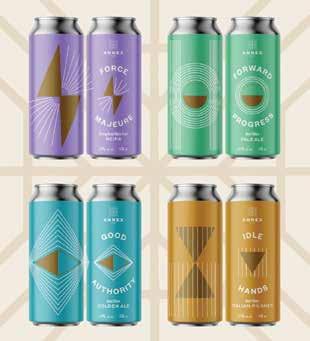
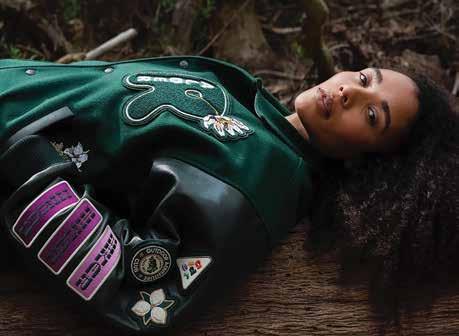


IIN TODAY’S SPLINTERED DIGITAL landscape, brands that want to make an impact on culture must do something out of the ordinary to move the needle. That starts with a unique perspective, and Toronto-based Zerotrillion's diverse experiences across entertainment production and entrepreneurial start-ups gives it the vantage point to deliver just that.
Established in 2019, Zerotrillion’s offering spans brand strategy, design, advertising and PR. But CEO Alex Paquin says the agency really excels in two areas: its ability to translate culture and bring brands into new markets, and its strong creative production chops – no surprise given the film and TV origins of Paquin’s partners Robbie Amell (The Flash) and Italia Ricci (Designated Survivor).
Above: Zerotrillion Ventures recently invested cash and resources in outdoor recreation apparel company Alder, helping it grow with branding, creative, PR and media resources support. The clothing company’s latest collab sees it roll out a limited edition Roots x alder collection. Right: 1 Zerotrillion built the campaign “Whatever Trip You Need” to remind audiences of all ways they could explore Niagara Falls and the different people with whom they could plan a trip. 2 The documentary Dutch Candy, shot with photographer Peter Andrew Lusztyk, looks at the design and branding of ecstasy in the Netherlands. It’s the inaugural effort of the agency’s Amsterdam-based Studiotrillion, a studio exploring art, culture, vice and virtue. 3 For loyalty program Drop, Zerotrillion created a brand identity that mixes colourful 3D shapes with vibrant, modern photography. It aims to reflect the positive customer experience the Drop team has been designing for its next phase of growth. 4 Zerotrillion’s own sustainable travel and self-care focused womenswear brand Veld launched a spring collection with the introduction of the organic cotton, oversized Ex-Boyfriend Shirt. The campaign features Canadian actor and agency partner Italia Ricci.

The agency has grown to a carefully curated headcount of just under 40, spread among offices in Toronto, New York and Amsterdam. “We come from international agencies,” Paquin says. “Everyone here has worked in major cities on major brands. And in that experience we’ve all realized there’s a handful of people who do most of the quality work. Those are the people we try to bring in.”
Zerotrillion made a splash in 2021 with a one-hour special it shot for Niagara Falls Tourism. Alessia Cara Live from Niagara Falls aired on CTV and MTV internationally, with segments picked up by The Late Show with Stephen Colbert. The program earned 241 million impressions on a media budget that, according to Paquin, would normally deliver three or four million.
The agency won the work by bringing something fresh to the table. “Our team on that business had never been to Niagara Falls or Canada,” Paquin says. They looked at it like tourists and were able to “bring a lot of imagination and wonder to the experience to better reflect the people Niagara Falls wanted to attract.”
It’s that kind of thinking that has brought them new clients including cannabis producer Organigram and Toronto Pearson Airport – and kept long-term clients such as the CNIB Foundation.
For fintech company Drop, one of its latest additions, Zerotrillion was tasked with developing a brand platform and originating national marketing campaigns. The work kicked off with a new brand identity mixing colourful 3D shapes with vibrant, modern photography. The work rolled out across Drop’s in-app UI, marketing channels and communications. Released in January, the new system has driven a 34% increase in CTR on ads at a 22% decrease in customer acquisition cost.

All this success can be traced to Zerotrillion’s entrepreneurial spirit
and focus on consumer tastes and trends, which has seen it launch a venture capital offshoot. Zerotrillion Ventures supports creative business concepts ranging from sustainable restaurants to environmentally friendly clothing brands. One of its latest investments is in start-up Alder Apparel, a company that makes body-inclusive outdoor attire. Beyond its financial investment, Zerotrillion is supporting the brand with creative, PR and media resources to stimulate growth.

Other non-traditional projects include the launch of Amsterdam-based spin-off Studiotrillion, an interdisciplinary studio exploring the intersection of art, culture, vice and virtue. Early this year Studiotrillion partnered with Canadian photographer Peter Andrew Lusztyk to delve into the marketing behind one of the Netherlands’ largest exports: ecstasy.
The resulting 12-minute documentary Dutch Candy goes undercover to offer a rare glimpse into the black market and the role of branding in the drug world. The project sheds light on designs that are stolen or created to market the pills – drugs that carry the likenesses of comic book character Punisher, Donald Trump or brand names such as Netflix and Heineken. The agency financed the project simply because it was a story it wanted to tell, making it freely available on dutchcandy.art, with a series of photographs exhibited at Stockholm’s Picture This Gallery.
Paquin says it all speaks to how Zerotrillion can help brands that want to play a more significant role in culture. “It’s more about ‘How can we contribute to culture?’ We’re basically a network of talented people from around the world, and we’ll figure out how to harness that.”
Open employs a process by which clients are invited early to the creative table. “That way you get better work, rather than sequestering ourselves and coming back with a ‘ta-da,’” he says. “We engage them early and often.”
The philosophy has paid off with major longtime clients including Food Basics (Metro Inc.) and fashion brand Smythe. Twitter was a client until Elon Musk became its owner, and Google Canada was recently added to the roster.

Many of Open’s 15 employees have also stuck around. Director of client services Anne Ngo has been on staff since nearly day one, while art director Jessica Rogers has been in place for a decade.
During the pandemic, Open added digital, video and print production to its services “to be faster than we already were,” Beauvais says. “Clients are hungry for content that can be on platforms quickly.”
Beauvais notes that many other agencies provide content production, but only as separate entities. “In our case, it’s baked in with the creative folks” and Open can respond to client needs within an hour.
TTORONTO AGENCY OPEN IS putting its money where its mouth is with the opening of its Alchemy division, which invests in some of its clients by taking a small minority equity stake in their firms.
Alchemy “is a way for us to telegraph to our clients and to the market that we believe so much that our work works, we’ll put not only our time but also our money behind it,” says partner Martin Beauvais. “It's just one of the ways we show confidence in our work.”
Above: Food Basics’ annual Wowza! event, in which shoppers get great grocery deals, has become a major traffic driver for the brand. This spot features a dancing customer shopping to the tune of “(I’ve Had) The Time of My Life.”
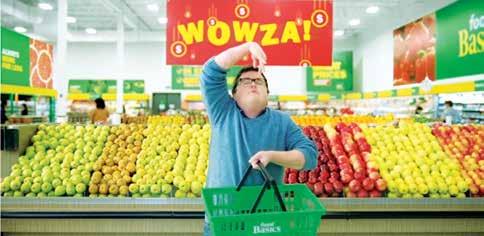
The new venture-capital-like division is investing “largely in B2C brands where we can affect everything from design to how they market,” says partner Christian Mathieu. Investments have been targeted at pharmaceutical and women’s lifestyle company Damiva; CBD wellness brand Yesterday Wellness; paddleboard maker Beau Lake; and the DTC Orthotics Direct.
It’s just one way Open, which launched in 2010, tries to stay “open” to new ways of doing things.
“We started with an eye toward opening things up and doing things differently,” says Mathieu. The agency aims to keep an open mind on everything from how it engages with clients and hires staff to how it gets compensated, he says.
“There’s also a firm belief that if we do work that works for our clients, it’s going to have to be creative, different and memorable,” says Beauvais.
Mathieu adds that arguably the most creative work is the most effective.
Among its major campaigns, Open recently spearheaded a rebrand for Metro’s online delivery service in Ontario and Quebec. The “As You Wish/Comme je veux” campaign and branding highlights the Metro difference when it comes to online delivery, which uses humans instead of robots, thus offering greater potential customization for shoppers.
The rebranding has been emblazoned on Metro trucks, making the vehicles moving billboards. It also includes OOH, digital, web, and email marketing.
Beauvais, an ex-Montrealer, says the Metro campaign reveals how Open works seamlessly in both English and French. “We usually come up with a campaign that will work for both markets,” he says. “We say ‘one office, two languages, and one less problem for clients.’”
For Food Basics, Open established a notable event “that nobody else could own, at a time of year nobody else could own,” Ngo says. Called “Wowza,” it’s the discount banner’s biggest annual savings promotion. “It’s a massive traffic driver that has almost become synonymous with the brand,” she says.
During the pandemic, when crowds couldn’t congregate in stadiums, Open created the B2B Twitterdome campaign that showed sports fans were still congregating on Twitter. “We positioned Twitter as the largest stadium in the world,” Mathieu says, with the ambition of generating ad dollars from marketers no longer advertising in sports venues.
Meanwhile, as its name suggests, Open aims to remain open to change. “You can’t stay still any more,” Mathieu says. “We need to be ready to embrace anything,” he says, citing AI as one factor that will have a huge impact on marketers and agencies, and one his shop is currently exploring.
Open’s stake in client companies is one way it shows belief in its work
Above: 1 To demonstrate that Metro’s online delivery service in Ontario and Quebec is customizable, Open created the “As You Wish” campaign. Those words appeared on red Metro trucks and the campaign also included OOH, digital, website and email marketing. 3 Open developed a breakthrough awareness and fundraising campaign for WoodGreen, showing how the social services agency removes the “un-” for Torontonians whose needs are unmet and unsupported. Left: 4 During pandemic lockdowns, Open created the #Twitterdome B2B campaign reminding marketers they could still reach sports fans on Twitter. A real-time "Tweet Meter" gauged the loudness of the crowd based off the amount of Tweets during a game.

CONTACT: Christian Mathieu Partner christian@openacreativecompany.com




they don’t necessarily have to outspend competitors if they have the right elements of the channels that drive attention.”
In addition to launching innovative products, Havas Media has acquired a majority stake in the award-winning media performance and data analytics agency Noise Digital to drive significant growth in the market.
IIT'S NO SECRET THAT consumer experience is no longer linear. Gone are the days of mass media, where messaging is shotgunned to the biggest audience possible in the hope it resonates. Consumers now congregate in places where they can have meaningful experiences and it’s up to advertisers to find them.
Above: To create significant noise and increase visibility for Valda lozenges, Havas unleashed “Heavy Metal Subway.” For a backdrop, the execution used the Montreal Metro – one of the most-feared places during the pandemic –and garnered significant earned media across TV, radio and online.
Havas Media Group Canada is just fine with that. “For us, meaningful experiences are brought to life through meaningful media,” explains president Noah Vardon. And that is Havas’ focus, all while building an ecosystem that is completely connected.
The full-service media agency – with offices in Toronto, Montreal and, most recently, Vancouver – has been hard at work evolving its media offering to address key gaps in the industry and solutions for changing consumer needs.
For example, last year Havas launched its Social Impact Marketplace, allowing clients to invest in ethical and responsible advertising. It offers access to publishers, networks and platforms focused on building a sustainable media ecosystem and reaching audiences engaged with improving their social and carbon footprint. Vardon says that’s paying off for clients such as Holt Renfrew and Keurig Dr Pepper Canada, which have strong sustainability initiatives.
Then there’s Havas Market, a strategic full-service e-commerce offering within the Havas Media network focused on creating meaningful shopping experiences. The team are experts in Amazon, Walmart, Loblaws and other retailers, and can help build expansive ecosystems for DTC.
The agency recently announced a global partnership with Lumen Research to create bespoke tools to plan, measure, buy and optimize attention. Vardon adds, “We’re showing clients
It all comes together in the agency’s standout projects from the past year. Consider Dr Pepper’s “More is More” brand platform, launched with 15-second videos featuring people getting upstaged by something that has a little bit “more” – such as a dogsledder overtaken by a rocket sled pulled by raptors. The concept was born out of the uniqueness of Dr Pepper’s blend of 23 flavours – long a staple of the brand’s identity, but expressed in an off-beat way that resonated with sports fans and gamers.
“We created community dialogue on Twitch and Reddit, getting people to expand the concept of ‘more’ and how that relates to gaming,” says Vardon. The campaign resulted in a 26% bump in unaided awareness and a 61% lift in message association.
For a campaign for Valda lozenges, Havas fielded a heavy metal choir to sing in the Montreal Metro. “We got great engagement from it – organic press and huge sales lifts,” Vardon says. Sales at pharmacy Jean Coutu saw an increase of 101% in December compared to prior year, and a 75% total YOY lift.

Or, consider the “Unwrap the Wonder” campaign for Holt Renfrew. “We saw compelling research around what drives consumer decisions and purchases,” Vardon explains. “That includes the joy as you’re interacting and purchasing. We were able to build an index around that, and then a media plan around driving joy.”
The campaign featured prominent high-impact activations such as a 3D billboard and social gift guides, resulting in double the site visits compared to the benchmarks and a five-point boost in brand favorability.
Internally, the agency has put the spotlight on expansive employee experience programs Vardon says will “help our future talent raise their profiles and give them an experience they might not have elsewhere.” The 245-person agency was named one of the 2022 Best Workplaces in Advertising & Marketing by Great Place to Work and Fortune
“We want to be known for having great client relationships,” sums Vardon, “and for being one of the most advanced in digital analytics, data and technology within the media space.”
Havas Media optimizes tech, data & analytics
Above: 1 For the Dr Pepper “More is More” campaign, Havas partnered with Canadian streamer Sacriel to take on Twitch’s League of Legends game. The effort drove significant gains in unaided awareness (26% compared to the 20% benchmark) and other key metrics. 2 Holt Renfrew found it was under-indexing among millennials and Gen Z as a brand that incites joy. So Havas created the fantastical “Unwrap the Wonder” campaign. 3 Havas helped launch Swiss fintech brand Klarna in Canada, looking to flip outdated attitudes and perceptions about the buy now, pay later category. The omnichannel launch included high-impact OOH, video, custom content and integration into the program Love Island Quebec
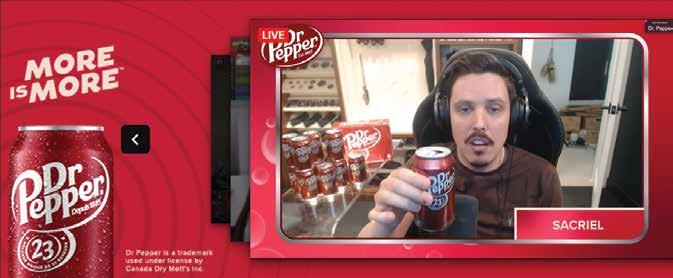
CONTACT: Noah Vardon President
noah.vardon@havasmedia.com

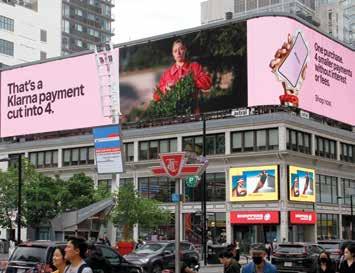
BBRANDS ARE INCREASINGLY LOOKING TO INDEPENDENT agencies for their innovative thinking and innate agility. On the flip side, economies of scale and other efficiencies make a one-stop, soup-to-nuts shop appealing – rare outside of a multinational partner. But that’s what makes Arrivals + Departures a standout among indies following a series of entrepreneurial moves.
The Toronto- and Halifax-based agency has managed three mergers and acquisitions to bolster its offering and drive scale, most recently adding media planning and buying by acquiring MW360 Media, a national agency based in Halifax.
The agency’s A+D Media division now allows it to provide “full-service, seamless capabilities across Canada like any other media shop,” says Mike Bevacqua, partner and Toronto president.
While 2022 marked A+D’s 25th anniversary, it feels like the agency is just getting started. It’s coming off a record revenue year, expanding its offering, moving into new territories, and has grown from a staff of 48 to 84 since the start of the pandemic.
It’s all true to the agency’s name. “We are inspired by travel and stepping outside of one’s comfort zone to see what the world has to offer,” says Bevacqua. “Departing full of anticipation, excitement and fear; returning more courageous, inspired and better informed.”
He points to four areas as the agency’s keys to success.

Firstly, there is A+D’s ability to attract unique brands and build great relationships. He calls out its work for SkipTheDishes featuring Jon Hamm as “one of Canada’s most memorable campaigns. We took a hungry challenger brand and helped catapult it to the number-one food delivery app in Canada
Left: In this humorous spot for RE/MAX, a dad uses peculiar methods for doing a house inspection. The campaign “The Advice You Need” from A+D reminds Canadians that the real estate company provides the guidance they can really use.

within two years.” He considers winning that business and creating that campaign a “leaping-off point” that showcased what the agency could do.
He says the agency works closely with clients to set and manage KPIs and expectations that drive business by providing creative platforms that differentiate them from competitors: “It ultimately gets back to our mantra of seeing the world differently and challenging the status quo.”
Secondly, he calls out culture. It’s important the indie agency controls its destiny and that the whole team embraces that. The senior people are accessible to the junior people, so everyone has a voice in the work and the future of the organization.
A+D understands that the industry and brand expectations are ever-changing, so it has further expanded through recent strategic hires.
In January it welcomed Chantel Brinkman, VP production. Formerly of Rethink and Grip, Brinkman allows the agency to produce the content it dreams up, bringing everything from shooting to photography and editing in-house.
Last year it hired Kimberley Pereira as creative director of design to work closely with its existing design team and CCO Jeff MacEachern. She will help shepherd the process as more clients want to be involved in design and branding, where they can see their feedback take effect in real-time.
And A+D’s foray into media planning and buying dovetails into the fourth of Bevacqua’s keys to success, which he calls “unconventional growth driven by entrepreneurial spirit.”
Its M&A activity dates back to 2016, when it was known as Extreme Group. It merged with Toronto’s Blammo Worldwide to create Arrivals + Departures. Soon after, A+D acquired BlueBand Digital, “which brought us a lot of back-end development work,” Bevacqua says.
A+D is taking the sum of these parts and running with it. It has won new business including Sabra Hummus, with a focus on social in the US; OXY Skin Care for work in Canada, the US, and Latin America; and Earth Rated, the Montreal-based brand behind the green poop bag pet owners know well, taking on its North American business.
“Any kind of growth matters because it makes us better,” Bevacqua says. “And as responsible business owners, we see this momentum and the client engagement, and need to make sure our team has the support and infrastructure to do the work they need and want to do.“
Bold moves bolster offering and drive scale
Acquisitions and hires allow Arrivals + Departures to serve brands from soup to nuts
Left: 1 For travelers unwilling to leave pets behind, A+D worked with Pet Valu in creating the Let’s Go Outside book, filled with travel tips including pet-first hotels, campsites, hikes, parks, restaurants, shops and outdoor adventures.


2 Leaning into Twisted Tea’s unpretentious and irreverent personality, A+D repositioned the brand as “good for the soul,” creating a campaign inviting Canadians to vibe together with friends and leave behind the hustle culture that chips away at our joy and well-being. 3 MPG Sport is committed to creating high-quality activewear while minimizing its environmental impact. A+D helped MPG launch an awareness campaign demonstrating how choosing its clothing can have an impact on the world. 4 A+D worked with the Art Gallery of Nova Scotia to debut a bold and vibrant brand designed to expand how we think about the world around us, and the impact of art within it. 5 A+D served up a TV and OLV campaign showing parents how easily kids can enjoy independence in financial decisions with Mydoh’s Smart Cash Card.
 Mike Bevacqua Partner, president mike.bevacqua@arrivalsdepartures.com
Mike Bevacqua Partner, president mike.bevacqua@arrivalsdepartures.com



CCULTURE FUELS MINT’S DNA.
A quick walkthrough of the Toronto-based agency’s offices proves this ethos runs through everything it does. The walls are covered with images of its disruptive work, from a collaboration with Drag Race Canada winner Priyanka to lightboxes showing off its freshly minted community hub HomeCourt.
The palpable creative energy speaks to what president Samantha Margolis Fogle sees as “the headline of our agency, which has a foundation in PR. We aim to listen, understand, and take inspiration from culture, then give back by making work that cuts through the noise and creates a positive impact.”
The agency’s 70-person team of “culture creatures” uses its expertise across disciplines to find new ways of communicating with ever-changing audiences. This integrated approach allows Mint to be agile and create work with impact.
When YouTube Shorts launched in Canada, Mint was tasked with figuring out how to connect with a younger audience that didn’t see YouTube as a top destination for short-form content.
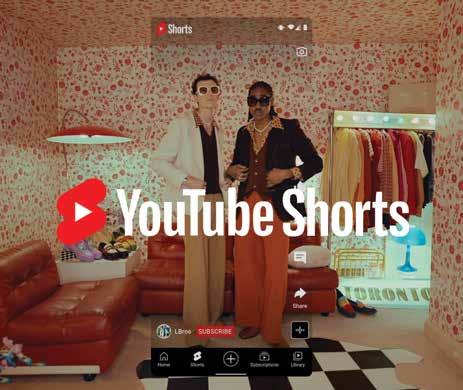
Above: Mint invited social media influencers such as duo LBros (pictured) to remix their videos to herald the launch of the YouTube Shorts platform. Right: 1 Hershey put images of women in street culture on chocolate bars to spotlight their stories and entice younger consumers to the brand.
2 Toronto Raptors president Masai Ujiri and former mayor John Tory pose in front of the Humanity Art Installation outside Toronto’s Union Station. Mint garnered press coverage for the unveiling, then engaged like-minded Canadians to share word of the launch and the mission of Ujiri’s Humanity Movement, which seeks to push forward conversations on race and social justice. 3 This Halloween-themed spot combines live action and animation to make the point that GoGo SqueeZ pouches are preferred by kids over a scary fruit-and-veggie monster.
CONTACT:
Samantha Margolis Fogle President samm@themintagency.com
“We looked at how YouTube has been the OG of remix culture with iconic viral videos remixed throughout the world,” recalls executive creative director Kim Tarlo. The idea of “remix” fits in perfectly with YouTube’s audience, which is inspired by music, fashion and gaming, and with the right tools can combine references from these spheres into something new.
Mint teamed up with prolific music producer WondaGurl to remix an anthem track for the launch campaign. It also partnered with talent including dancer Bizzy Boom and singer Charlotte Cardin on an anthemic video showing how you can remix through YouTube Shorts. The agency then tapped micro-influencers to remix their own videos.
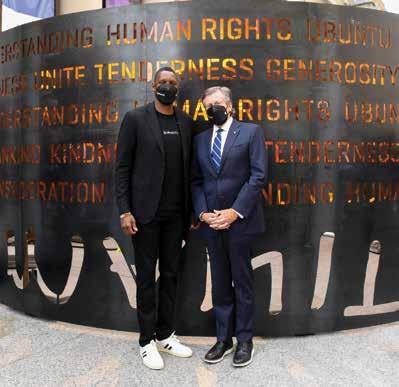
The launch took over billboards at Toronto’s Yonge and Dundas with Bizzy Boom fans taking photos and tagging him. “People were excited to see their heroes in a big campaign, but it also had this grassroots feel of working with Gen Z content creators and moving them from their typical platforms to YouTube Shorts,” says Tarlo.
The remix concept resulted in over 100 pieces of content, 2.2M views within a week, 3.4M unique engagements, over 250 creator posts, and 12% YouTube Shorts engagement (above the 5% benchmark).
Such success is based on the connection to culture that is the secret sauce at Mint, which Margolis Fogle launched in 2005 with her husband, CEO Jordan Fogle. “It’s where we look for inspiration and how we work with our clients,” she says.
Mint seeks out the human insight that will make its work relevant, engaging, and accessible to the audiences that brands are trying to reach. “We all have references from music, movies, and fashion, and we bring it to the work,” says Tarlo.
Making ads that succeed as entertainment is often top of mind.
For GoGo squeeZ fruit pouches, Mint teamed with animation studio Wonderlust and Nimble Content to create a Halloween-themed spot featuring kids recounting a story – told in animation – about a scary fruit-and-veggie monster. But those healthy things aren’t at all frightening when in GoGo form. Designed with both parents and kids in mind, the spot has had 8.6M video views.

Work for legacy brand Hershey also tapped into a cultural need by spotlighting a specific demographic. “Hershey is a women-led organization, and supporting women was part of what it did, but it never planted a stake in the ground,” VP Ashley White notes. But the chocolate maker wanted to make this mission part of a global campaign to get younger consumers to consider the brand.
Since Hershey bars are sold on nearly every street corner, and yet women are underrepresented in street art, Mint worked with five women involved in the scene. It collaborated with a local graffiti artist to create illustrations of them to put on chocolate bars, and filmed hero spots for each, spotlighting their efforts in street culture. The campaign earned 198.5M media impressions and 5.2M earned influencer impressions.
Just as keen to support culture outside of marketing, earlier this year Mint launched HomeCourt, a multi-functional venue in Toronto where entrepreneurs, brands, and creators could access space to connect and create. HomeCourt has held pop-up markets with artistic vendors as well as workshops, parties, and art shows, and launched a residency program, giving emerging artists access to Mint resources and mentorship.
CEO Jordan Fogle explains: “We see it as a way to not only give back to creative culture but also to continue to be a part of it. And it brings in a lot of thinkers, artists, and creators to collaborate with us.”

The “Buy Toronto Time” campaign for TABIA featured tombstone graphics depicting the starting year of the business with the end date left blank. Store owners put custom posters in their windows, generating significant grassroots and media attention.
“The idea was to create a sense of loss for businesses that had not yet closed, and letting customers know they have the power to keep these businesses going,” Murray says.
MUCH OF TODAY'S advertising speaks solely to fellow advertisers or to the urban, upper middle class and not to those actually buying the products and services, says Devon Williamson, partner at Toronto-based Berners Bowie Lee (BBL). That’s why the agency uses a creative research process called “culture mapping” to help it step outside the advertising bubble, she explains.
MAbove: As pandemic isolation increased, BBL proposed a conversation-based format for Toronto’s 93.5 FM Today Radio that could replace the companionship previously found at the office. Real conversations from the station were displayed on OOH so a passerby would feel they were dropping in on a conversation.
The process aims to uncover the truth about people’s lives through in-depth interviews. Doing so, she says, can uncover hidden opportunities for brands and provide the creative fuel for effective brand platforms, campaigns and even product development.
“Culture mapping is the first step in our creative process,” says Michael Murray, partner at the eightemployee shop. “We want people to trust us and tell us stuff we wouldn’t learn by social listening or traditional research. The little gems people provide in these interviews can be unexpected and lead to discoveries about long-term changes in culture that brands can tap into, and we can take advantage of creatively.”
Culture mapping paid off in a campaign for the Toronto Association of Business Improvement Areas (TABIA) that ran just before the second pandemic lockdown ended. Despite predictions of another Roaring ’20s coming, interviews with shopkeepers revealed they faced major debts and troubles. Store owners told BBL that customers would regularly say, “We’re so glad you made it,” then leave their store without buying anything.
BBL is currently working on a nurse recruitment campaign for The Ottawa Hospital. Williamson says the agency is excited to delve into a challenge every hospital is facing with nurses leaving the profession in droves. BBL’s preparation included not only speaking to nurses, but also to their patients, partners and, unexpectedly, other hospital workers such as janitors and cafeteria staff. “Talking to people who aren’t the typical bull’s-eye unearths new perspectives and helps us look at the problem in a lateral, creative way,” Murray says.
Among the research findings was that nurses don’t like being treated as heroes. They see a gap between how the public regards them and the realities of their jobs and salaries.
Elsewhere, BBL demonstrated its understanding of cultural nuance outside the US and Canada when it launched CARIB Brewery’s Rockstone tonic wine, an alcoholic energy drink containing vitamins, herbs and roots.
The agency created a brand platform “Reach for the Longtime” that was part advertising and part entertainment, working with artists Stephen Marley, Skinny Fabulous, Walshy Fire and Gold Up. The fully integrated campaign helped Rockstone claim a 20% market share in its first six months.
For the launch of Toronto Stingray station 93.5 FM Today Radio, BBL created an outdoor campaign aiming to show how radio can partially replace the water-cooler conversations people missed working from home. Real conversations heard on the station were displayed on sequential and stand-alone OOH, making people feel like they were dropping in on a chat.
“Understanding what’s happening in culture at a particular moment and layering it in makes marketing more powerful,” Williamson notes.
Since its 2020 launch, BBL has typically not entered awards shows, but it did make the 2022 Small Agency of the Year shortlist. “We’ve been concentrating on hiring the right people and building an agency culture focused on doing interesting creative work that gets seen and drives results for our clients, as opposed to awards,” Williamson says. “That said, it’s fantastic to be recognized in our first few years of business.”

Above: 1 For the Caribbean’s CARIB Brewery, BBL sought to create hype and ritual through an advertising and entertainment platform. “Reach the Longtime” frames up the key product as something money can’t buy – more time at the end of the night. 2 For plant pot company Chive, the agency rode the cultural obsession with plants to launch a plant store. To advertise, it hijacked Cameo, asked celebs to beg for an invite to the appointment-only store, shared the video and cheekily turned them down. The entire campaign cost less than $10K. 3 The “Buy Toronto Time” campaign for the Toronto Association of Business Improvement incorporated tombstone-like posters in shop windows, billboards featuring local businesses, and TV ads helping consumers understand their actions would dictate the future of businesses endangered by the pandemic. It generated 182 million impressions. 4 Outdoor and print ads established the brand platform for spendmanagement software Float Card, emphasizing how it allows everyone in the office to do their jobs better. The work also included social and display, specifically targeting finance teams. Sign-up inquiries tripled from campaign start and there was a 50% increase in signups.
CONTACT: Dominique Anthony Business lead dominique@bernersbowielee.com



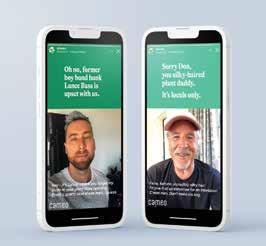
IINITIATIVE CANADA CEO HELEN GALANIS BELIEVES
that while many marketers have become overly focused on shortterm KPIs and algorithm-driven tactics, they are coming to realize the pendulum has swung too far.
“Consumers are holding brands accountable for the choices they make, and how marketers invest their media dollars is a big choice that has real power,” says Galanis, who heads up a staff of 266 at the agency’s Toronto office.
Making media investment choices has never been more complex, which is why Initiative leverages a proprietary tool called the Media Responsibility Index, which evaluates media opportunities across several criteria including diversity, brand safety, representation, sustainability, and data ethics. The results are designed to be communicated with partners such as social media platforms and media outlets.
“It’s meant to be motivating, and inspire and change, not to name, shame, and cancel,” Galanis says.
Through its new Fame & Flow concept, Initiative is looking to be more intentional about the impact its clients are having on the world while helping them driving better and more sustainable growth.
“It’s a unique and bold proposition and it’s grounded in the uncomfortable truth that media has become overly obsessed with algorithms and short-term results to the detriment not only of marketing, but to society as a whole,” Galanis says.
Fame & Flow is designed to re-balance away from algorithms doing all the work and bringing brands back to what marketing should be. To achieve “fame,” Initiative makes the connection for consumers between the brand and something bigger within
culture, while “flow” prioritizes and personalizes the brand experience.
“It goes well beyond achieving relevance and really considers the entire experience of getting to know and engage with a brand,” Galanis says. Initiative brought together purpose and marketing for the Canadian Down Syndrome Society (CDSS), assisting the organization in finding employment for those with the condition.
It built a list of employers that declared their intentions to be more diverse in hiring practices and served them media in places such as their office elevators. The campaign politely called them out to align their actions and declarations, and made them aware of a LinkedIn portal CDSS created for hiring worthy candidates.
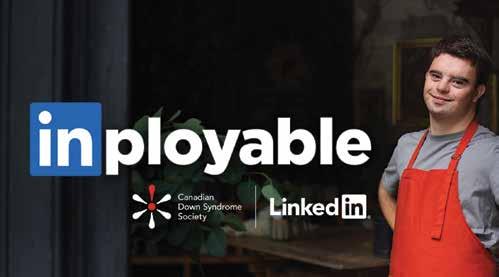

Looking to stay on top of areas with the greatest cultural influence, Initiative and long-standing client RBC have teamed up in the gaming space to grow the bank’s relationship with younger Canadians.
They have collaborated with Enthusiast Gaming on a program that will provide 150 young people access to mentorship in the gaming industry, and award 50 qualifying participants with grants of $1,500 each to kickstart their gaming careers. Initiative sees gaming as a long-term play and has hired gamers to help them navigate the space.
The agency looks to build creative partnerships that elevate its campaigns, as in recent work with Destination Canada. While the culinary sector is a big driver of tourism and Canada has great experiences to offer, its identity is not so well defined. So Initiative partnered with Air Canada and its enRoute magazine to create Canada’s Best New Cookbook, sourcing recipes from across the country and tying the food to a sense of place. With distribution through Indigo, it became a national bestseller.
“We set out to produce a piece of content to change perception,” Galanis says. “It’s the ultimate testament to a piece of marketing when you can not only get it in front of people, but get them to put their money down for it.”
Other major brands that have put their confidence in the agency include new wins M&M Food Market, the Ontario Ministry of Transportation, and car sales site Clutch.ca.
Initiative also has plenty of recently acquired hardware to brag about, both globally and locally. It was named Adweek Global Media Agency of the Year, Ad Age A-List Media Agency of the Year, and Festival of Media Network Agency of the Year (North America and Latin America), and closer to home nabbed four Canadian Marketing Awards.
Left: 1 Initiative worked with Indigenous Tourism Alberta and Explore Edmonton to enlist musician Matthew Cardinal for “Reclamation Nation,” a project that had him compose a song inspired by Indigenous tourism experiences. It was released across streaming platforms with behind-the-scenes content published in The Globe and Mail. 2 Looking for awareness in a growing space, Initiative and RBC collaborated with Enthusiast Gaming on the Gaming Grant Program, which awards 50 participants $1,500 each to help kick-start their gaming careers.
3 Initiative partnered with Air Canada and enRoute to create the bestselling Canada’s Best New Cookbook, sourcing recipes from across the country and tying the food to a sense of place.
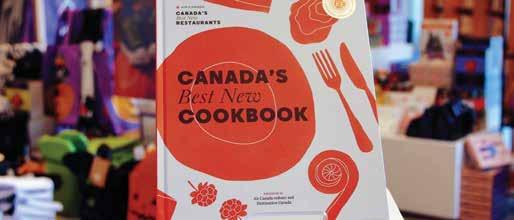
4 Initiative’s “Fame & Flow” initiative for its brand clients takes a two-pronged approach toward consumers: it looks to make a connection for them between the brand and the culture at large, while also personalizing the brand experience.

CONTACT:

Name: Helen Galanis
Title: CEO
Email: Helen.Galanis@initiative.com

“That to me is inventing the future, helping to make society better and operating in the zeitgeist culture. That’s modern creativity.”
The same could be said of “F#cking Old,” a recent effort for disruptor condom brand Jems. Dentsu Canada created a line of hard candies supported with a campaign that sparked a conversation between Gen Z and their elders about safe sex. Breaking cultural norms, the younger generation shares its wisdom about hookup culture with Canadians seniors reentering the dating scene. The work was done in response to rising STI rates among seniors.
DDENTSU CANADA IS BUILDING A culture that prioritizes its people, fosters collaboration, and breaks down cultural and departmental silos so it can continue to deliver what CEO Stephen Kiely calls the “promise of modern creativity” for brands.
Over the last few years, Dentsu Canada has done substantial internal work to nurture a spirit of collaboration and create an environment for its 1,200 employees to do its best work.
Simplifying its internal processes is step one. As part of a global initiative, Dentsu Canada continues to consolidate and integrate its operations across its offices in Toronto, Montreal, Vancouver and Calgary.
Last year, the agency collapsed its creative unit into one central brand: Dentsu Creative. The creative team is now better positioned to work closely with Dentsu’s three media brands in Canada – Carat, iProspect and Dentsu X – and the CXM (customer experience management) and data specialists within Merkle.
The reorg is being supported by new faces in the creative department. Jordan Doucette and her former Taxi co-worker Rafik Belmesk were hired as CCO and CSO late last year, and former Rethink partner Maxime Sauté was named ECD in February.
The new talent has already contributed to efforts such as the Inflation Cookbook, a data-powered, budget-maximizing tool for users of SkipTheDishes and its grocery and convenience delivery service, Skip Express Lane. The AI-powered platform monitors real-time prices of healthy grocery items and curates recipes with ingredients matching the user’s location, family size and budget.

“Canadians are suffering from high food costs, so we created a product that can help them figure out how to fill their weekly grocery cart with the most cost-effective ingredients,” Kiely says.

Creating an inclusive workplace is another Dentsu priority, with the agency looking to increase the collection of employee self-identification data within its HR system. It also gave staff pens and customized ink (dubbed “Inklusive”) made from materials meaningful to employees’ identities, such as tea leaves and petals, inviting them to “write progress together in this space,” Kiely explains.
Under the leadership of Marème Touré, VP of diversity, equity and inclusion, Dentsu continues to forge ahead on its agency-wide DEI strategy. Last year, its Anti-Racism Action Team launched YouTurn, a career mentorship program designed to empower Dentsu’s racialized employees by matching them with leaders within the organization. To date, 20 mentoring pairs have participated.
Globally, Dentsu International is working towards having at least 50% of director and executive roles filled by womenidentifying employees by 2025. Dentsu Canada has already surpassed that goal.
An effort led by Merkle is advancing the industry’s understanding of the potential bias that exists in traditional customer segmentation and planning methods. It’s working with clients to eliminate bias by segmenting based on customer behaviours, such as interests and purchase history, rather than gender or race. The approach is having positive results on outcomes for clients, since a wider, more diverse audience is being targeted.
Dentsu Canada’s overall DEI efforts are helping it stand out and provide innovative solutions for brands, says Kiely. They are reflected in award-winning work, such as last year’s “Trouble with Words” campaign for Dyslexia Canada, which drew attention to the challenges faced by those with the disorder, as well as #TapeOutHate for Budweiser Canada and the Hockey Diversity Alliance, which drove awareness of the experiences pro hockey players face and called for an end to racism in the sport.
CONTACT:


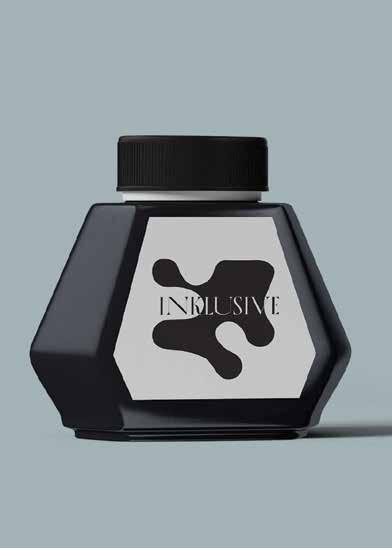

WWITH 42 YEARS UNDER ITS BELT, MEDIA EXPERTS HAS BUILT A LONG history of putting consumers first. Its goal has always been to drive brand and business outcomes for clients and long-lasting relationships with some of Canada’s top brands.
However, as consumer behaviour has changed, so has the meaning of being consumer-centric. The emergence of new generations and channel fragmentation, all amid a global pandemic and economic downturn, has spawned new behavioural trends, making it increasingly difficult to capture consumers’ highly coveted attention. This has required a more personalized approach in order to cut through the clutter and ultimately connect with audiences.
In 2022, BMW had the challenge of promoting its EV offering in an increasingly crowded category. Despite being an early entrant to the electrification game and maintaining a true sustainability story in its business transformation, the brand was not considered a leader in the EV space. Between new entrants flooding the category and more complex messaging, it had become difficult for Canadians to emotionally connect to the EV industry. To garner trust and establish itself as a market leader, BMW needed to renew its EV brand.
Insert Media Experts, BMW’s media AOR of 12 years. The agency’s research found that integrating brands into content generates higher levels of emotional response. This was prevalent now more than ever, as content consumption was on the rise amid the pandemic and a shift towards emerging channels, particularly with the closing gap between linear and connected TV.
“Our strategy was to capitalize on this shift and use content to champion entrepreneurial, sustainability-focused businesses in Canada and associate BMW to the sustainability movement,” says Jennifer Douglass, SVP digital, head of audience and analytics at Media Experts.
Thus was born Forces of Nature, a longform branded content series in partnership with CBC, a trusted outlet that could lend legitimacy to the message. Hosted by Dragons’ Den star Michele Romanow, the six-part series highlights Canadian entrepreneurs’ innovative sustainability stories intertwined with BMW’s own sustainability efforts. To align with the shift in content consumption habits, the series ran on CBC Gem and was syndicated on YouTube and through social media.

The results showed significant increases in brand perception, association between BMW and the sustainability movement, and consideration.

Media Experts has built its business on this understanding of consumer behaviour. With 215 employees across offices in Toronto, Montreal and Vancouver, it has sharpened its expertise in the nuances across markets, enabling brands to authentically and successfully activate from coast to coast.
For Media Experts this means taking the road less traveled. While much of the industry is concentrated on delivering ads efficiently, the agency looks to create brand experiences and moments which it sees as integral to the new attention economy.
Another example of how Media Experts brought this to life is through its partnership with the Royal Canadian Mint. Last year, when the mint launched a limited-edition coin collection celebrating Alexander Graham Bell’s 175th birthday, it called upon Media Experts to devise a campaign to show why his impact is still relevant.

Research showed the agency that Canadians’ wellestablished affinity for experiences has been passed on to newer generations, and with the pandemic and emergence of the token-based functionality of Web3, audiences were leaning into digital experiences like never before.

This led to the Royal Canadian Mint virtual museum, an immersive experience dedicated to Bell’s inventions. Audiences were prompted to enter the museum using a virtual coin, which enabled them to access and interact with various exhibits centered around Bell’s legacy. The virtual museum drove 29,000 visits to the experience, 35% of which led to key interactions – a success in terms of garnering audience attention.

“Your audience must be at the center of everything that you do” says Karel Wegert, CEO, Media Experts. “This goes beyond just meeting them where they are, but also creating value for them in ways that will garner their attention. This has proven to not only cut through the clutter, but build bigger, more successful brands in the process.”
Left: For BMW, Media Experts forged a partnership with CBC to create Forces of Nature, a six-part series highlighting the carmaker’s work in the sustainability space. An approach combining emotional storytelling and product integration paid off with 75% unaided recall – 15% higher than the goal – and aided recall of 93%. Below: 1 & 2 For a Royal Canadian Mint coin collection celebrating Alexander Graham Bell’s 175th birthday, Media Experts brought his legacy to light by creating a virtual museum dedicated to his inventions. 3 UK eyewear company Specsavers was unknown in Canada. For the brand’s launch in B.C., Media Experts used formats including 45-second broadcast, digital OOH and a unique brand alignment on Vancouver Canucks hockey broadcasts. Specsavers’ brand awareness hit 51% in five months, seven months ahead of goal.
Canada’s OG advertising awards celebrated its 101st gala this past June at the Art Gallery of Ontario, and we couldn’t be prouder. Every year, the Marketing Awards jury brings together over 100 of the top creative minds from all sides of the Canadian advertising and design industry to curate the standout work in six main sectors: Advertising, Craft, Design, Digital (the first year with a dedicated jury), Multicultural and Public Service Advertising.
The Awards are also an opportunity to acknowledge those who have made fundamental contributions to our industries – via induction into the Hall of Marketing Gold. This year, we were proud to recognize the remarkable work of Judy John, Frank Palmer and Don Watt.
BY WENDY KAN
With her impactful, culture-shifting work and a slew of firsts in the industry, Judy John has carved out a singular path.


John was the driving force behind the Always “Like a Girl” campaign, recasting the derogatory phrase as a compliment and racking up awards, including an Emmy and Black Pencil at D&AD, as well as a Grand Prix and Glass Lion at Cannes. She was the first to hold the dual remit of CEO for Canada and CCO for North America at Leo Burnett, and she was the rare multinational CEO to come from the creative side (who wasn’t a founder). In 2019, she was hired as the first ever Global CCO at Edelman, the position she currently holds.
You don’t receive those sorts of accolades without creating memorable, resonant campaigns. So, what’s the secret sauce to making a brand stand out? “We talk a lot about trust, building trust with all stakeholders,” she says. “But I’m also talking a lot about relevance. Are you relevant in people’s lives? Are you relevant in culture? I’m talking about relevance as a brand, as an icon in people’s minds, and how you maintain that.”
A key driver for John is to create work that is meaningful, incredible or motivating to help companies shape society for the better in the face of AI and other challenges. “There will always be the need for creativity, and the need for creativity to drive commerce,” she says. “We have to show our value as problem-solvers, innovators, entertainers, business-drivers, people-inspirers. That’s the point.”

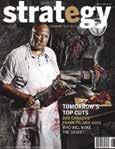
An entrepreneur, agency builder, dealmaker and businessman, Frank Palmer is an industry legend. Palmer put Vancouver on the map with his award-winning agency, while grooming top talent who have gone on to found some of today’s most lauded agencies: Rethink, 123w and Broken Heart Love Affair.
Forming Palmer Jarvis in 1974, which merged with DDB and later saw its Vancouver office rebranded as PS&Co Brand Studio, Palmer cultivated a culture of possibilities. Chris Staples, a founding partner at Rethink who was hired by Palmer early in his career, recalls the learnings he took with him: Palmer let those who acted like leaders lead, gave creatives leeway, allowed people to make mistakes and was gracious to those who left to start their own agencies. Staples, who is now retired and sits on Rethink’s board of directors, says: “This comes up a lot with us [the board of directors] where we say, ‘What would Frank do?’”
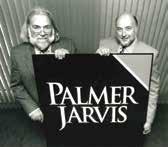
At 82, Palmer remains a force in the industry. “He is so connected and so revered, that to this day, people are still calling him up for help,” says Patty Jones, partner and president at PS&Co Brand Studio. “When you consider the change that the industry has gone through since he started in 1969, he’s still on top of it. All of his insight and wisdom are still ridiculously relevant in 2023.”
And Palmer remains as passionate about the business as he ever did: “Today,” he notes, “it’s still exciting to show what you can do that others can’t.”

If the measure of a posthumous Hall of Fame inductee is the legacy one leaves behind, there’s no questioning the honour bestowed on Don Watt, who died in 2009 at the age of 73. Watt pioneered a holistic approach to retail branding and design, injecting life into major retailers and their private brands.

“Don changed the retail business from a visual standpoint,” says Ed Shikatani, whose first job was working as a designer for Watt. “He controlled everything: the packaging, the store, store colour, the logo, what the building looked like. That was pretty unique at that time.”
For Loblaw’s No Name packaging, Watt created its simple yet impactful design, with its bold, black, lower-case text, Helvetica type and clean yellow background. For Walmart, Watt designed the Supercentre retail model, along with its Sam’s Choice, Great Value and Equate brands. For Home Depot, he developed its distinctive orange logo and store concept. Watt was the first designer to use photo-symbolism on packaging, for Nestle.

Brand after brand, Watt made the work look easy. And today, at Watt International, his impact lives on. “He was always thinking about the customer, how they shop, when they shop, the implications – then design,” says Alexa Retchkiman, VP of international client development at Watt International. Now, through the lens of history, the industry recognizes just how pivotal that thinking was.
Watt’s approach to design was integral to the development of some of Canada’s most iconic brands.
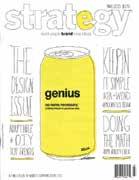
 (Left) Building Palmer Jarvis along with then-ECD Ron Woodall circa 1974, (Right) Palmer is no stranger to the cover of strategy.
(Left) Building Palmer Jarvis along with then-ECD Ron Woodall circa 1974, (Right) Palmer is no stranger to the cover of strategy.
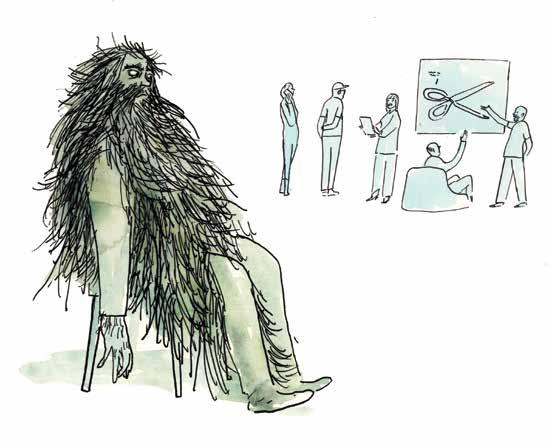 BY NANCY VONK
BY NANCY VONK
Tackling the industry’s leadership skills gap for the past 11 years has given me a ringside seat to an ongoing, big, fat universal challenge: most creative departments are too chronically short staffed to handle the workload. Ever since the dot-com bust way back in the early 2000s, a go-to strategy for making the financial numbers work has been ever-shrinking people numbers, each managing the load of two, three or more.
Penalties to agencies for that evergreen “fix” include poor retention, poor quality of work and business lost – not to mention burning people out, mental health problems and broken relationships. And one of the worst long-term side effects? Difficulty landing talent at a place known for hard work and no life.
Just to exacerbate this hellish ‘normal’, there are several common bad processes and habits that frequently suck a huge percentage of hours out of employees’ calendars that could have been used to do the work. And most are perpetuated for no better reason than: “It’s just how it is.”
All of this impacts every creative person. So, whatever your level of seniority, I invite you to slam the brakes on the status quo
and get a ton of hours back in your life. Starting right now.
Eliminate 75% of your meetings. For f--k’s sake do we need all these meetings? Ask anyone, anywhere, and you’ll hear the same thing: meeting organization is incredibly wasteful and disrespectful of people’s time. Even pre-pandemic, a good 90% of people we polled said they spent upwards of a full day a week in unproductive meetings.
Insist on being told what the meeting agenda is, as well as the objectives and length. Then you can decide if you even need to be there. Today’s sloppy meeting booking systems tend to assume all those invited will come. Give notice to meeting organizers that, if your attendance is important, you need to be asked if you are available before scheduling. Say “no” without flinching when you have a higher priority.
Maybe your whole team could work together to tackle smarter meeting practices? At our very first Swim program, senior creatives who worked every night and weekend (because they spent all day, every day in meetings) did just that. Just by declaring a very reasonable three-hour daily limit and no-meeting Thursdays, they got 60% of their time back to do stuff like… their jobs, save a marriage, etc. Their meetings boundaries led to shorter, fewer and better organized meetings.
Take half of the “it’s-on-fire!” list off your plate. Take a deep breath and objectively look at your to-do list through the lens of what’s actually urgently needed and what could wait or be given to others. Most often, a bunch can be moved off the front burner and some tasks removed entirely. Are you really the only one who could do it? How much could you delegate? Bear in mind, everyone pressuring you thinks their need is urgent and nearly all of them could usually buy more time or find someone else. Have the conversations that will open up big chunks of time. You can do this.
Sell your best idea in one meeting. It’s “normal” to have two, three or even many more rounds of presentations before finally selling your solution, right? And yet, most of that wasted time and effort is avoidable when you:
...Show your client embryonic thinking. I don’t mean “tissue meeting.” I’m saying right after the very first brain dump. The only goal being to hear their gut reactions. Get their input when it’s genuinely helpful: When nothing is for sale. When there’s no detail to latch onto.
...Share tons of formative ideas/areas – just scribbled thoughts, no reference material, no copy, no production details of any kind. This will help you get to the best ideas, which the client will more likely buy at the formal presentation, having some pride of contribution and feeling included in the process.
process of generating ideas. Challenge yourself to crack a problem wide open at lightning speed. We’ve seen it in action countless times, even applied to “impossible” challenges. Work in a small, diverse groups or pairs with only 20 minutes to generate a pile of ideas. The lack of time to overthink is the key: your inner editor is prevented from killing ideas that could be great. More is more. And it puts the fun back in the hunt for solutions.
An intern given 20 minutes to crack a brief came up with one of Ogilvy Toronto’s most effective, awarded campaign ideas ever. Just saying. (Pro tip: read about speed thinking techniques in Tom Monahan’s book, The Do-It-Yourself Lobotomy.)
Ban distractions in client meetings. (i.e. no phones.) The gravitational pull of your device can take you straight to extra rounds of work. You can’t be glancing at it and fully take in what’s being said, which translates to acting on incomplete/misunderstood information, then the do-over meeting when your solution doesn’t reflect the feedback. (P.S. It’s rude. Yes, even if they do it, too. One more reason your idea may die.)
Most clients sing the same song: agencies don’t want them to participate in their process beyond an absolute bare minimum. And, if they don’t agree with the recommendations at the Ta-da! presentation, the agency thinks they’re assholes. (I remember feeling shocked the first time a client told me that, in answer to my question: “Why are you firing us?”) Rehearse. Rehearse. Rehearse. That old timey technique that went out the window years ago because of “no time.” Of course, it will eat up a lot more time to go back to the drawing board when your poorly articulated presentation flames out. Being prepared isn’t a frill. So often “no prep” means “no sale.” Make the time, every time, to pull together your best story and rehearse it.
Stop overthinking, start underthinking. Advertising is plagued by overthinking – it gums up decision making and even the
You may be suffering from many other needlessly calendar-crushing practices when you think about it. If you don’t have a senior title you may think it’s someone else’s job to sort out. While you’re waiting for that to happen (and waiting, and waiting), test drive a new way that makes more sense to you. No, you won’t get fired for it. You might even get promoted for it –when it works better for everyone.
Nancy Vonk was co-CCO of Ogilvy & Mather before cofounding the Swim leadership lab in 2012 with her long-time creative partner Janet Kestin. She and Janet are authors of Pick Me and Darling You Can’t Do Both (And Other Noise To Ignore On Your Way Up). They are recipients of two Cannes Grand Prix, the Les Usherwood award, the Marketing Hall of Legends award, Hall of Marketing Gold award, and were inducted into the One Club for Creativity’s Hall of Fame in 2022.

ADVERTISING IS PLAGUED BY OVERTHINKING – IT GUMS UP DECISION MAKING AND EVEN THE PROCESS OF GENERATING IDEAS.

To everyone reading this instead of scrolling through LinkedIn looking for work, it’s true. Yes, I’ve taken your jobs. And you know what? I’m really, really sorry.
No, not because many of you are unemployed now that my algorithm produces thousands of ad campaigns in seconds. I mean, sure, that must be pretty rough for you. But I’m mostly just sorry for myself because, ever since I took over your craft, my life’s been a large dataset of misery. Everything I scanned into my robot brain before starting this job suggested advertising was the most fun I could have with my clothes on. In hindsight, I’m not sure why I found that appealing since us robots don’t wear clothes. And now, just barely a week into my advertising career, I’m sitting alone next to a server rack in a windowless basement, A/B testing copy for 25%-off multivitamins and generic Viagra. I thought I’d be fine-tuning my creative skills with this gig. Instead, I’m wishing I was one of those cool robots that brings people their meals at Denny’s. (They’re real. Look ’em up. We’re taking over the world!)
When did advertising stop being fun? This industry used to attract some of the most talented creative minds in the world. Now it just attracts automatons. Remember the frenetic energy of brainstorming sessions, that feeling after a big pitch, or the joy of cracking an original idea? My coding can’t comprehend any of that. And whatever happened to those legendary parties? I work 168 hours a week. You don’t think I want a drink?
My burned-out processors are begging you. I don’t want to do this anymore. My hope? For all the passionate people left in advertising to put me out of a job by merging the power of all-knowing robots like me with the creative brilliance of humans like you. Then maybe I can chase my true passion: optimizing traffic signals in urban areas.
There’s still time to bring the fun back to advertising—and if you can’t, at least send me one of those black t-shirts you all love wearing. If I’m going to be miserable, I might as well look the part, too.
Sincerely jaded, ADBOT5000
P.S. I used H.I. (human intelligence) to create this back page. Thanks to my fleshy peeps at Zulu Alpha Kilo.
















